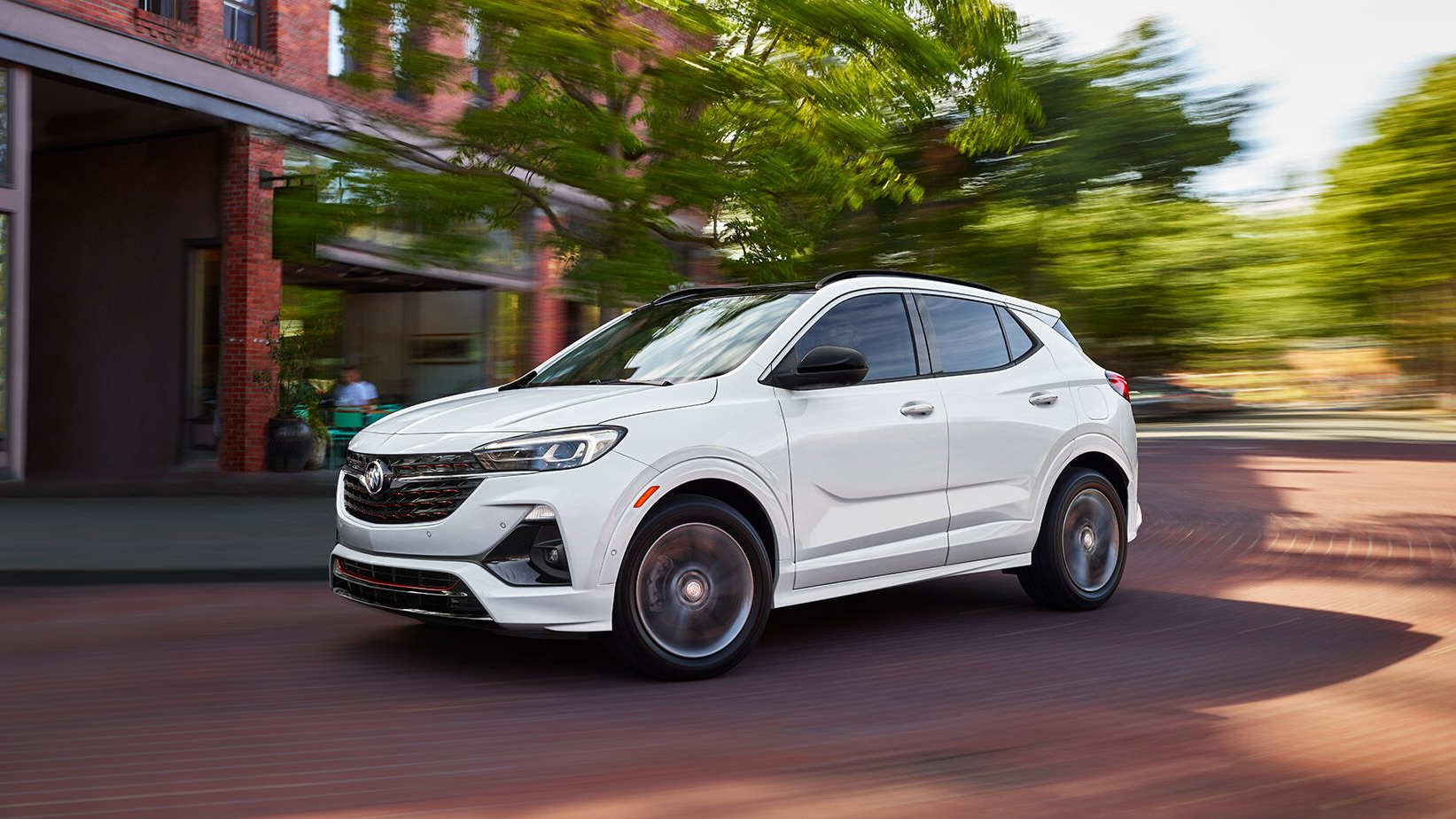Buick Encore GX 2023 Vehicle Care User Manual
General Information
General Information
For service and parts needs, visit your dealer. You will receive genuine GM parts and GM-trained and supported service people.
Genuine GM parts have one of these marks.
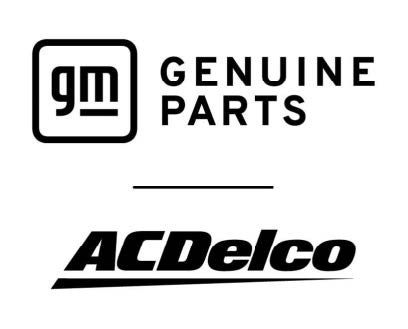
California Perchlorate Materials Requirements
Certain types of automotive applications, such as airbag initiators, seat belt pretensioners, and lithium batteries contained in electronic keys, may contain perchlorate materials. Perchlorate Material – special handling may apply. See www.dtsc.ca.gov/hazardouswaste/perchlorate.
Accessories and Modifications
Adding non-dealer accessories or making modifications to the vehicle can affect vehicle performance and safety, including such things as airbags, braking, stability, ride and handling, emissions systems, aerodynamics, durability, Driver Assistance Systems, and electronic systems like antilock brakes, traction control, and stability control. These accessories or modifications could even cause malfunction or damage not covered by the vehicle warranty.
Damage to suspension components caused by modifying vehicle height outside of factory settings will not be covered by the vehicle warranty.
Damage to vehicle components resulting from modifications or the installation or use of non-GM certified parts, including control module or software modifications, is not covered under the terms of the vehicle warranty and may affect remaining warranty coverage for affected parts.
GM Accessories are designed to complement and function with other systems on the vehicle. See your dealer to accessorize the vehicle using genuine GM Accessories installed by a dealer technician.
Also, see Adding Equipment to the Airbag-Equipped Vehicle page 61.
Vehicle Checks
Doing Your Own Service Work
Warning
It can be dangerous to work on your vehicle if you do not have the proper knowledge, service manual, tools,
or parts. Always follow owner’s manual procedures and consult the service manual for your vehicle before doing any service work.
If doing some of your own service work, use the proper service manual. It tells you much more about how to service the vehicle than this manual can. To order the proper service manual, see Publication Ordering Information page 344
This vehicle has an airbag system. Before attempting to do your own service work, see Servicing the Airbag-Equipped Vehicle page 60.
If equipped with remote vehicle start, open the hood before performing any service work to prevent remote starting the vehicle accidentally. See Remote Vehicle Start page 14.
Keep a record with all parts receipts and list the mileage and the date of any service work performed. See Maintenance Records page 331
Caution
Even small amounts of contamination can cause damage to vehicle systems. Do not allow contaminants to contact the fluids, reservoir caps, or dipsticks.
Hood
Warning
For vehicles with auto engine stop/start, turn the vehicle off before opening the hood. If the vehicle is on, the engine will start when the hood is opened. You or others could be injured.
Components under the hood can get hot from running the engine. To help avoid the risk of burning unprotected skin, never touch these components until they have cooled, and always use a glove or towel to avoid direct skin contact.
Clear any snow from the hood before opening.
To open the hood:
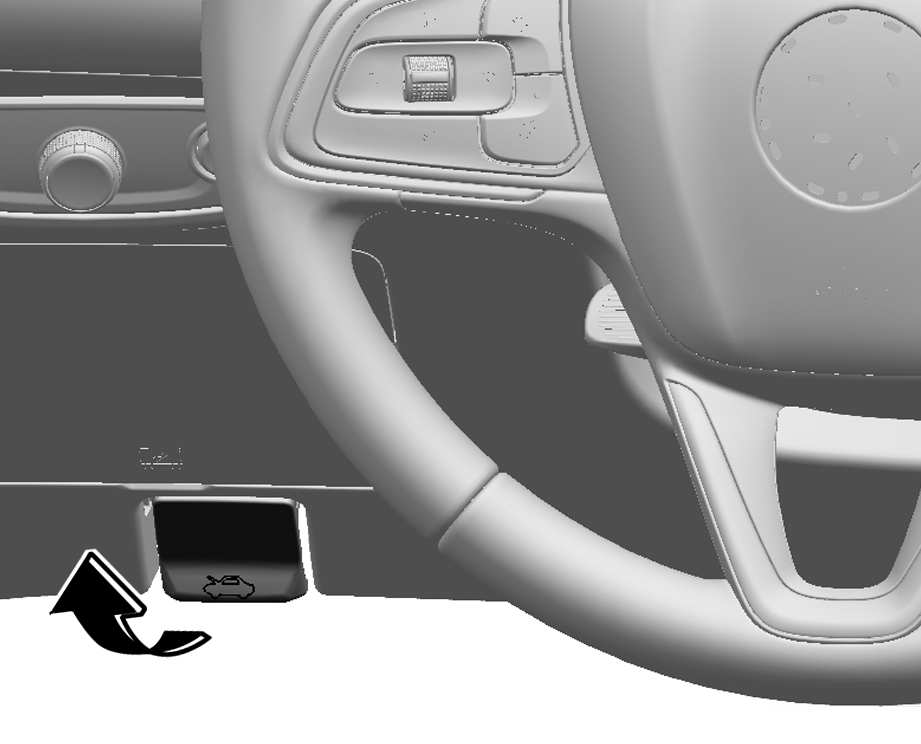
- Pull the hood release handle inside the vehicle. It is located on the lower left side of the instrument panel.

- Go to the front of the vehicle and move the secondary hood release lever toward the right side of the vehicle.
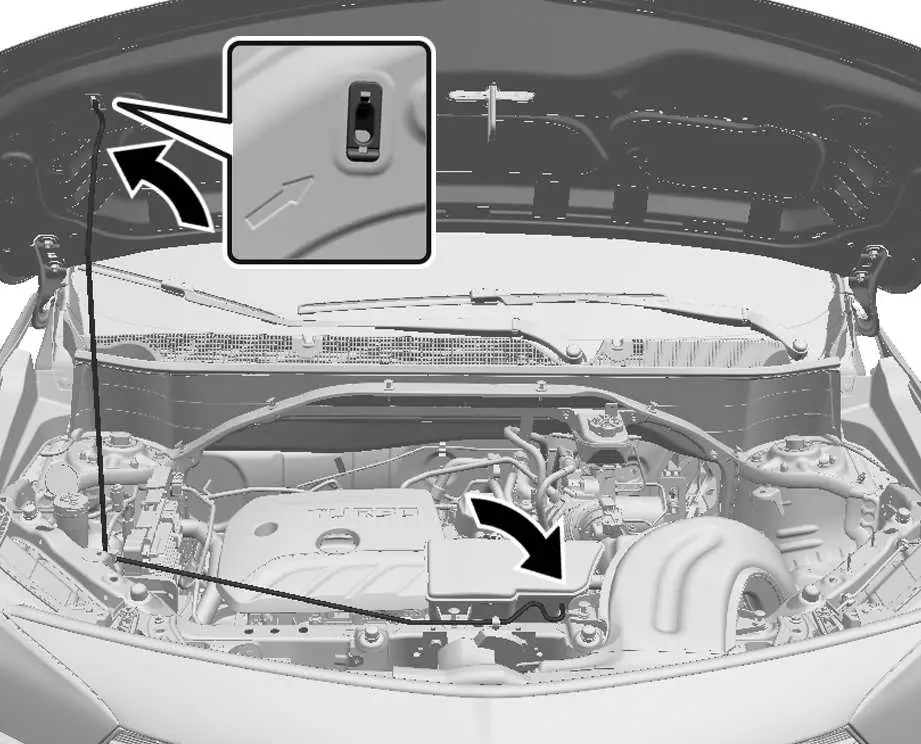
- Lift the hood and release the hood prop from its retainer, above the radiator. Securely place the hood prop into the slot on the underside of the hood.
To close the hood:
- Before closing the hood, be sure all filler caps are on properly, and all tools are removed.
- Lift the hood and remove the hood prop rod from the underside of the hood. Return the prop rod to its retainer. The prop rod must click into place when returning it to the retainer to prevent hood damage.
- Lower the hood 30 cm (12 in) above the vehicle and release it so it fully latches. Check to make sure the hood is closed and repeat the process if necessary.
Warning
Do not drive the vehicle if the hood is not latched completely. The hood could open fully, block your vision, and cause a crash. You or others could be injured. Always close the hood completely before driving.
Engine Compartment Overview
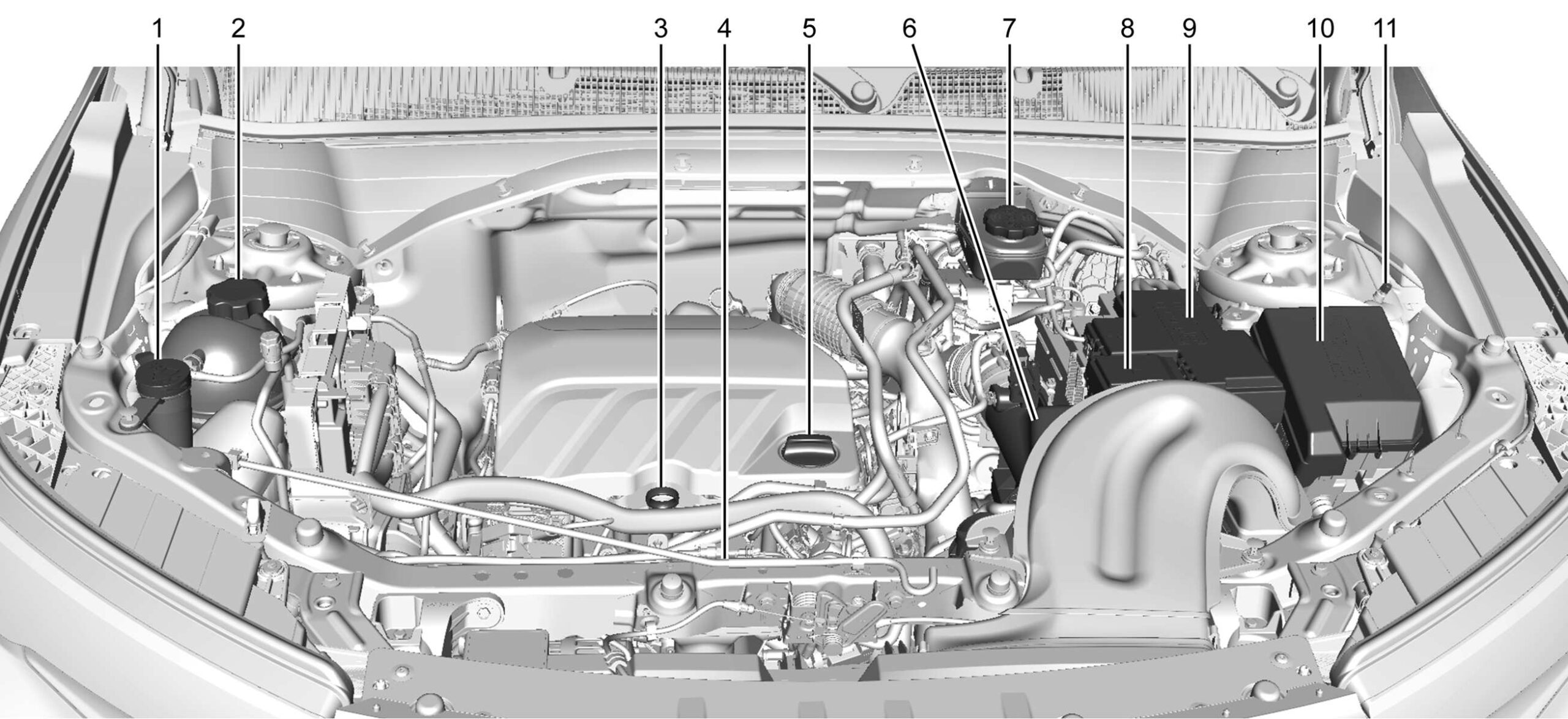
1.2L L3 Engine (LIH)
- Windshield Washer Fluid Reservoir. See Washer Fluid page 265.
- Engine Coolant Surge Tank and Pressure Cap. See Cooling System page 260.
- Engine Oil Dipstick. See Engine Oil page 256.
- Engine Cooling Fan (Out of View). See Cooling System page 260.
- Engine Oil Fill Cap. See Engine Oil page 256.
- Engine Air Cleaner/Filter page 259.
- Brake Fluid Reservoir. See Brakes page 266.
- Positive (+) Battery Terminal. See Jump Starting – North America page 309.
- Battery – North America page 268.
- Engine Compartment Fuse Block page 280.
- Remote Negative (-) Battery Terminal. See Jump Starting – North America page 309
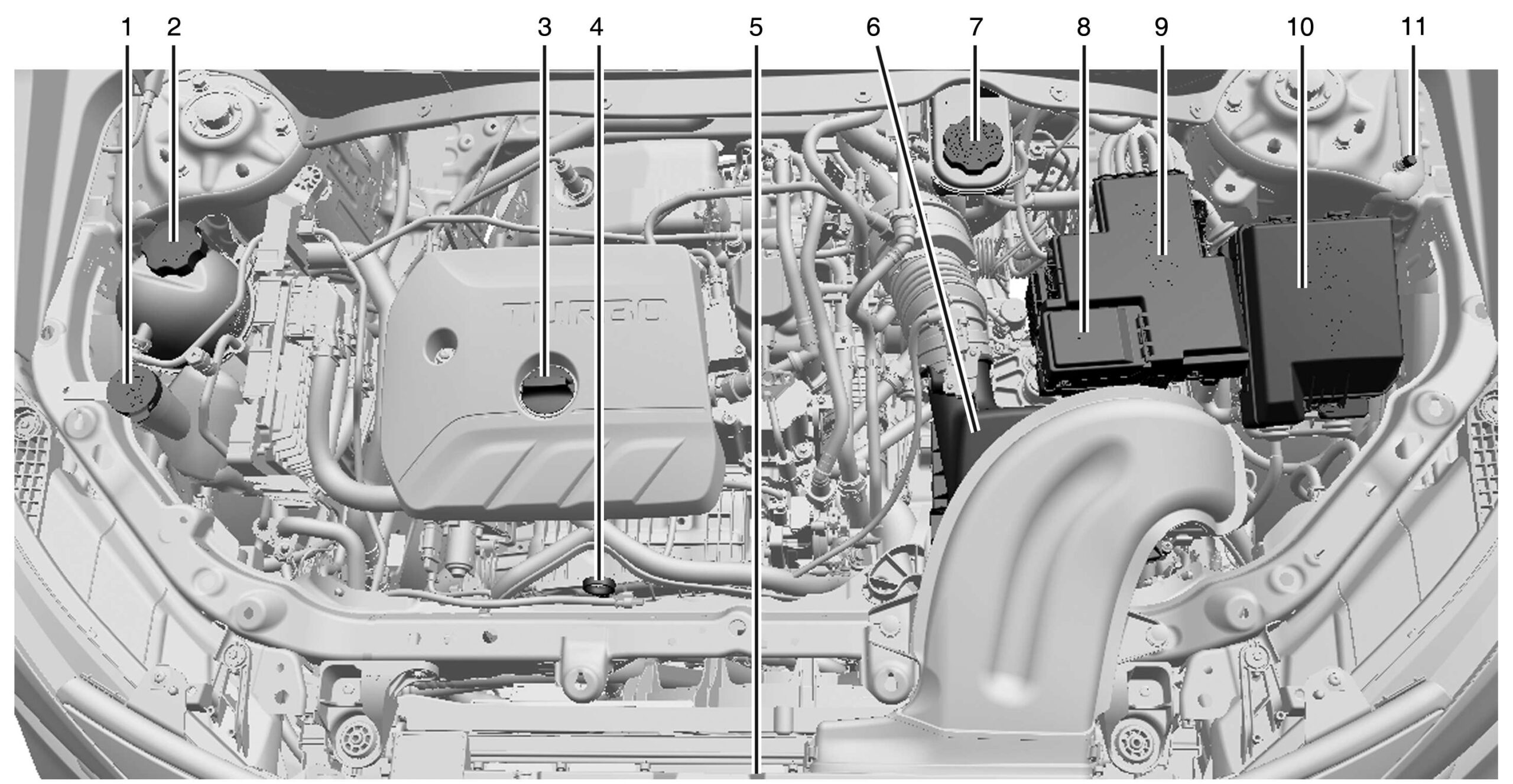
- Windshield Washer Fluid Reservoir. See Washer Fluid page 265.
- Engine Coolant Surge Tank and Pressure Cap. See Cooling System page 260.
- Engine Oil Fill Cap. See Engine Oil page 256.
- Engine Oil Dipstick. See Engine Oil page 256.
- Engine Cooling Fan (Out of View). See Cooling System page 260.
- Engine Air Cleaner/Filter page 259.
- Brake Fluid Reservoir. See Brakes page 266.
- Positive (+) Battery Terminal. See Jump Starting – North America page 309.
- Battery – North America page 268.
- Engine Compartment Fuse Block page 280. Remote Negative (-) Battery Terminal. See Jump Starting – North America page 309
Engine Oil
To ensure proper engine performance and long life, careful attention must be paid to engine oil. Following these simple, but important steps will help protect your investment:
- Use engine oil approved to the proper specification and of the proper viscosity grade. See “Selecting the Right Engine Oil” in this section.
- Check the engine oil level regularly and maintain the proper oil level. See “Checking Engine Oil” and “When to Add Engine Oil” in this section.
- Change the engine oil at the appropriate time. See Engine Oil Life System page 258.
Always dispose of engine oil properly. See “What to Do with Used Oil” in this section .
Checking Engine Oil
Check the engine oil level regularly, every 650 km (400 mi), especially prior to a long trip. The engine oil dipstick handle is a loop. See Engine Compartment Overview page 253 for the location.
Warning
The engine oil dipstick handle may be hot; it could burn you. Use a towel or glove to touch the dipstick handle. If a low oil Driver Information Center (DIC) message displays, check the oil level.
Follow these guidelines:
- To get an accurate reading, park the vehicle on level ground. Check the engine oil level after the engine has been off for at least two hours. Checking the engine oil level on steep grades or too soon after engine shutoff can result in incorrect readings. Accuracy improves when checking a cold engine prior to starting. Remove the dipstick and check the level.
- If unable to wait two hours, the engine must be off for at least 15 minutes if the engine is warm, or at least 30 minutes if the engine is not warm. Pull out the dipstick, wipe it with a clean paper towel or cloth, then push it back in all the way. Remove it again, keeping the tip down, and check the level.
When to Add Engine Oil

L3T 1.3L L3 Engine

LIH 1.2L L3 Engine
If the oil is below the cross-hatched area at the tip of the dipstick and the engine has been off for at least 15 minutes, add 1 L (1 qt) of the recommended oil and then recheck the level. See “Selecting the Right Engine Oil” later in this section for an explanation of what kind of oil to use. For engine oil crankcase capacity, see Capacities and specification page 333.
Caution
Do not add too much oil. Oil levels above or below the acceptable operating range shown on the dipstick are harmful to the engine. If you find that you have an oil level above the operating range, i.e., the engine has so much oil that the oil level gets above the MAX mark, the engine could be damaged. You should drain out the excess oil or limit driving of the vehicle and seek a service professional to remove the excess amount of oil.
See Engine Compartment Overview page 253 for the location of the engine oil fill cap.
Add enough oil to put the level somewhere in the proper operating range between the MIN and MAX marks. Push the dipstick all the way back in when through.
Selecting the Right Engine Oil
Selecting the right engine oil depends on both the proper oil specification and viscosity grade. See Recommended Fluids and Lubricants page 328.
Specification
Use full synthetic engine oils that meet the dexos1 specification.
Engine oils that have been approved by GM as meeting the dexos1 specification are marked with the dexos1 approved logo. See www.gmdexos.com.

Caution
Failure to use the recommended engine oil or equivalent can result in engine damage not covered by the vehicle warranty.
Viscosity Grade
Use SAE 5W-30 viscosity grade engine oil. Cold Temperature Operation: In an area of extreme cold, where the temperature falls below −29 °C (−20 °F), an SAE 0W-30 oil may be used. An oil of this viscosity grade will provide easier cold starting for the engine at extremely low temperatures.
When selecting an oil of the appropriate viscosity grade, it is recommended to select an oil of the correct specification. See
“Specification” earlier in this section.
When selecting an oil of the appropriate viscosity grade, it is recommended to select an oil of the correct specification. See “Specification” earlier in this section.
Engine Oil Additives/Engine Oil Flushes
Do not add anything to the oil. The recommended oils meeting the dexos1 specification are all that is needed for good performance and engine protection.
Engine oil system flushes are not recommended and could cause engine damage not covered by the vehicle warranty.
What to Do with Used Oil
Used engine oil contains certain elements that can be unhealthy for your skin and could even cause cancer. Do not let used oil stay on your skin for very long. Clean your skin and nails with soap and water, or a good hand cleaner. Wash or properly dispose of clothing or rags containing used engine oil. See the manufacturer’s warnings about the use and disposal of oil products.
Used oil can be a threat to the environment. If you change your own oil, be sure to drain all the oil from the filter before disposal.
Never dispose of oil by putting it in the trash or pouring it on the ground, into sewers, or into streams or bodies of water. Recycle it by taking it to a place that collects used oil.
Engine Oil Life System
When to Change Engine Oil
This vehicle has a computer system that indicates when to change the engine oil and filter. This is based on a combination of factors which include engine revolutions, engine temperature, and miles driven. Based on driving conditions, the mileage at which an oil change is indicated can vary considerably. For the oil life system to work properly, the system must be reset every time the oil is changed.
When the system has calculated that oil life has been diminished, it indicates that an oil change is necessary. A CHANGE ENGINE OIL SOON message comes on. Change the oil as soon as possible within the next 1 000 km (600 mi). It is possible that, if driving under the best conditions, the oil life system might indicate that an oil change is not necessary for up to a year. The engine oil and filter must be changed at least once a year and, at this time, the system must be reset. Your dealer has trained service people who will perform this work and reset the system. It is also important to check the oil regularly over the course of an oil drain interval and keep it at the proper level.
If the system is ever reset accidentally, the oil must be changed at 5 000 km (3,000 mi) since the last oil change. Remember to reset the oil life system whenever the oil is changed.
How to Reset the Engine Oil Life System
Reset the system whenever the engine oil is changed so that the system can calculate the next engine oil change. To reset the system:
- Display the REMAINING OIL LIFE on the See Driver Information Center (DIC) (Base Level) page 108 or Driver Information Center (DIC) (Uplevel) page 115.
- Press and hold
 on the DIC while the Oil Life display is active. The oil life will change to 100%.
on the DIC while the Oil Life display is active. The oil life will change to 100%.
If the CHANGE ENGINE OIL SOON message comes back on when the vehicle is started, the engine oil life system has not been reset. Repeat the procedure.
Automatic Transmission Fluid
It is not necessary to check the transmission fluid level. A transmission fluid leak is the only reason for fluid loss. If a leak occurs, take the vehicle to the dealer and have it repaired as soon as possible. Change the fluid at the intervals listed in Maintenance Schedule page 324, and be sure to use the transmission fluid listed in Recommended Fluids and Lubricants page 328.
Caution
Use of the incorrect automatic transmission fluid may damage the vehicle, and the damage may not be covered by the vehicle warranty. Always use the correct automatic transmission fluid. See Recommended Fluids and Lubricants page 328.
If you need to check the transmission fluid level, take the vehicle to your dealer.
Engine Air Filter Life System
If equipped, this feature provides the engine air filter’s remaining life and best timing for a change. The timing to change an engine air filter depends on driving and environmental conditions.
When to Change Engine Air Filter
When the REPLACE AT NEXT OIL CHANGE message displays, the engine air filter should be replaced at the next engine oil change.
When the REPLACE ENGINE AIR FILTER SOON message displays, the engine air filter should be replaced at the earliest convenience. The system must be reset after the engine air filter is changed.
If the CHECK AIR FILTER SYSTEM message displays, see your dealer.
How to Reset Engine Air Filter Life System
Reset the system whenever the engine air filter is replaced so that the system can calculate the next engine air filter change.
To reset:
- Place the vehicle in P (Park).
- Select Engine Air Filter Life on the DIC menu. See Driver Information Center
(DIC) (Base Level) 0 108 or
Driver Information Center (DIC) (Uplevel) page 110.
- Select Engine Air Filter Life on the DIC menu. See Driver Information Center
- Press
 or the thumbwheel to move to the Reset
or the thumbwheel to move to the Reset  Disable display area. Select Reset then press l or press the thumbwheel. Then press Yes to confirm the reset.
Disable display area. Select Reset then press l or press the thumbwheel. Then press Yes to confirm the reset. - 100% AIR FILTER LIFE will be displayed when the Engine Air Filter Life System is successfully reset.
Engine Air Cleaner/Filter
The engine air cleaner/filter is in the engine compartment on the passenger side of the vehicle. See Engine Compartment Overview page 253.
When to Inspect the Engine Air Cleaner/ Filter
If the vehicle is not equipped with the engine air filter life system, see Maintenance Schedule page 324 for intervals on inspecting and replacing the engine air cleaner/filter.
- How to Inspect/Replace the Engine Air Cleaner/Filter
Do not start the engine or have the engine running with the engine air cleaner/filter housing open. Before removing the engine air cleaner/filter, make sure that the engine air cleaner/filter housing and nearby components are free of dirt and debris.
Do not clean the engine air cleaner/filter or components with water or compressed air.
To inspect or replace the air cleaner/filter:
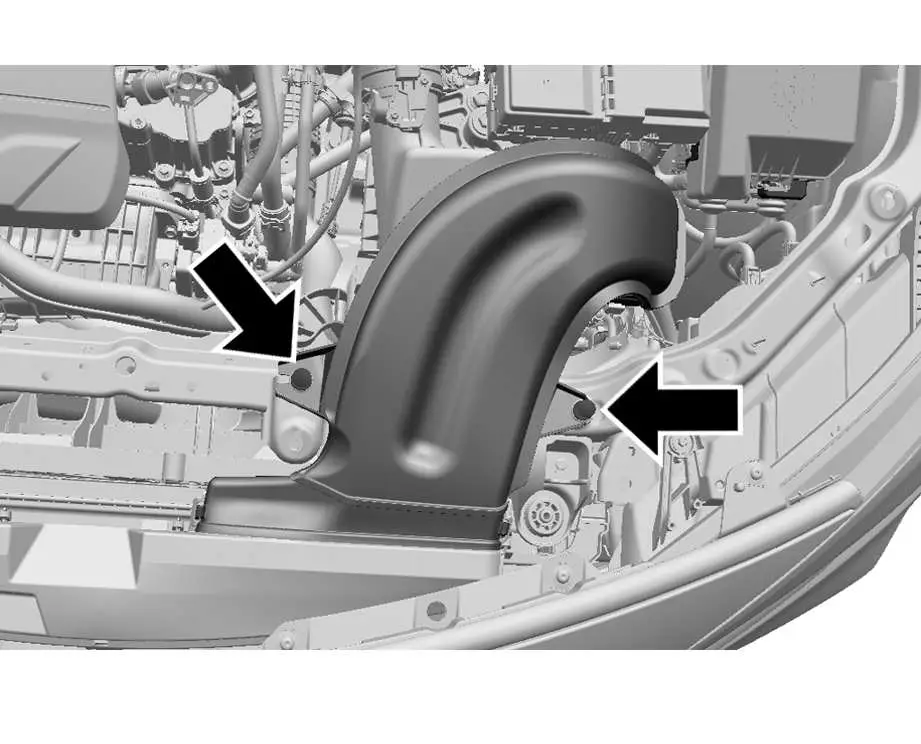
- Remove the five screws and lift the cover off the air cleaner/filter housing.
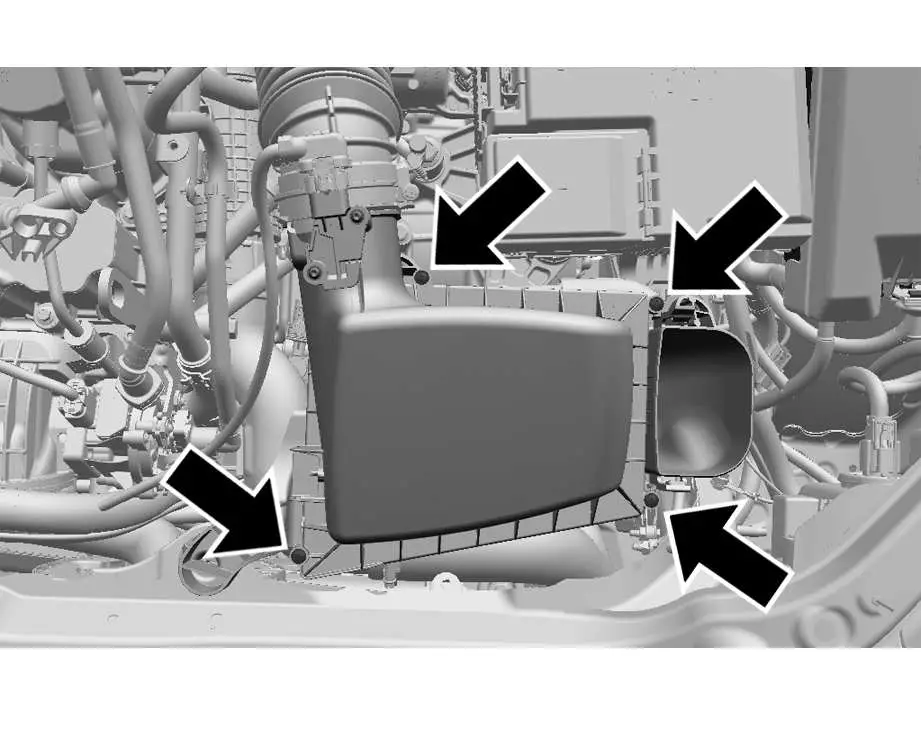
- Press a hook both sides and disassemble two hooks.

- Disassemble the duct.

- Remove four screws, tilt the cover, and slide it out of the assembly.
Warning
If part replacement is necessary, the part must be replaced with one of the same part number or with an equivalent part. Use of a replacement part without the same fit, form, and function may result in personal injury or damage to the vehicle. - Inspect or replace the engine air cleaner/filter.
Lower the cover, slide it into the assembly, then secure with the screws. - If equipped, reset the engine air filter life system after replacing the engine air filter. See Engine Air Filter Life System page 259.
See Maintenance Schedule page 324 for replacement intervals.
Warning
Operating the engine with the air cleaner/filter off can cause you or others to be burned. The air cleaner not only cleans the air; it helps to stop flames if the engine backfires. Use caution when working on the engine and do not drive with the air cleaner/filter off.
Caution
If the air cleaner/filter is off, dirt can easily get into the engine, which could damage it. Always have the air cleaner/filter in place when driving.
Cooling System
The cooling system allows the engine to maintain the correct working temperature.
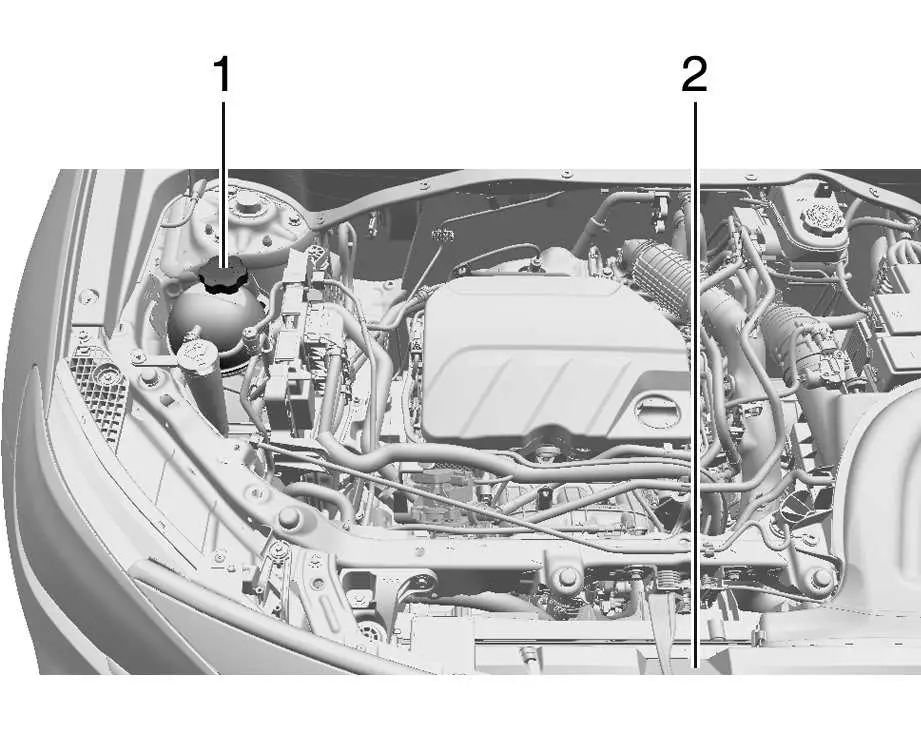
1.2L L3 Engine (LIH)
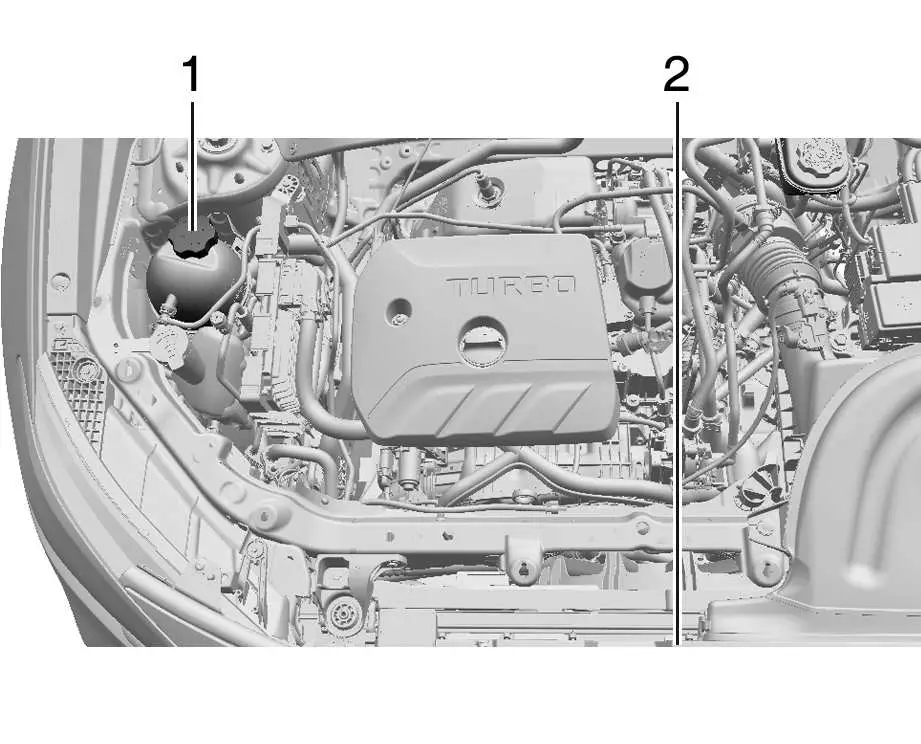
1.3L L3 Engine (L3T)
- Engine Cooling Fan (Out of View)
- Engine Coolant Surge Tank and Pressure Cap
Warning
An underhood electric fan can start up even when the engine is not running and can cause injury. Keep hands, clothing, and tools away from any underhood electric fan.
Warning
Do not touch heater or radiator hoses, or other engine parts. They can be very hot and can burn you. Do not run the engine if there is a leak; all coolant could leak out. That could cause an engine fire and can burn you. Fix any leak before driving the vehicle.
Engine Coolant
The cooling system in the vehicle is filled with DEX-COOL engine coolant. This coolant is designed to remain in the vehicle for five years or 240 000 km (150,000 mi), whichever occurs first .
The following explains the cooling system and how to check and add coolant when it is low. If there is a problem with engine overheating, see Engine Overheating page 264
What to Use
Warning
Plain water, or other liquids such as alcohol, can boil before the proper coolant mixture will. With plain water or the wrong mixture, the engine could get too hot but there would not be an overheat warning. The engine could catch fire and you or others could be burned.
Use a 50/50 mixture of clean, drinkable water and DEX-COOL coolant. If using this mixture, nothing else needs to be added. This mixture:
- Gives freezing protection down to −37 °C (−34 °F), outside temperature.
- Gives boiling protection up to 129 °C (265 °F), engine temperature.
- Protects against rust and corrosion.
- Will not damage aluminum parts.
- Helps keep the proper engine temperature
Caution
Do not use anything other than a mix of DEX-COOL coolant that meets GM Standard GMW3420 and clean, drinkable water. Anything else can cause damage to the engine cooling system and the vehicle, which would not be covered by the vehicle warranty.
Never dispose of engine coolant by putting it in the trash, pouring it on the ground, or into sewers, streams, or bodies of water. Have the coolant changed by an authorized service center, familiar with legal requirements regarding used coolant disposal. This will help protect the environment and your health.
Checking Coolant
The vehicle must be on a level surface when checking the coolant level .
It is normal to see coolant moving in the upper coolant hose return line when the engine is running.
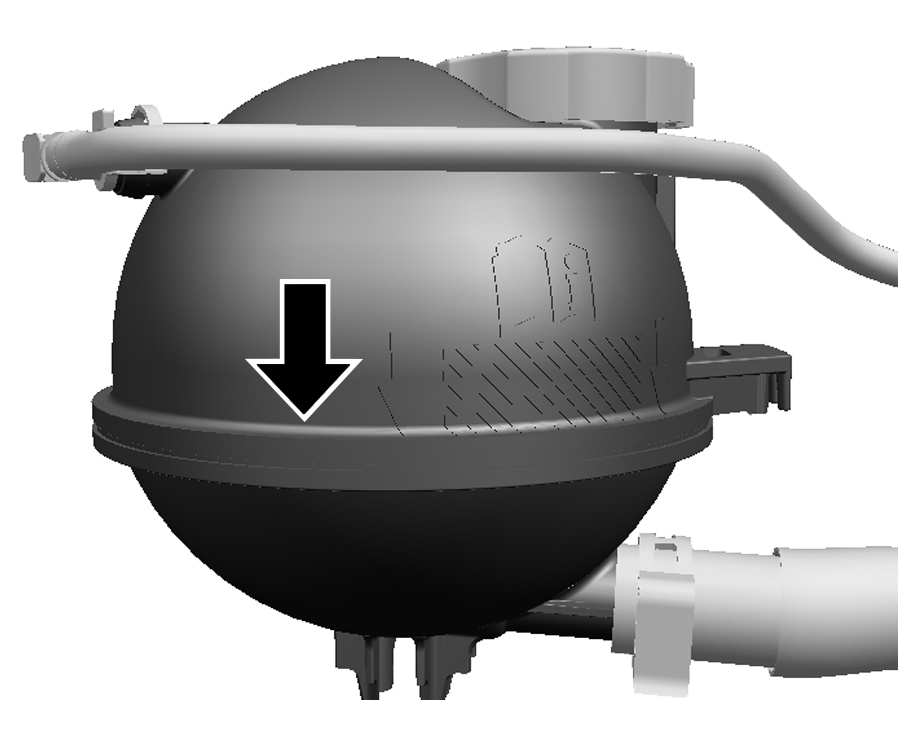
Check to see if coolant is visible in the coolant surge tank. If the coolant inside the coolant surge tank is boiling, do not do anything else until it cools down. If coolant is visible but the coolant level mark is not visible, add a 50/50 mixture of clean, drinkable water and DEX-COOL coolant at the coolant surge tank to the top rib on the middle of the tank, but be sure the cooling system is cool before this is done.
If no coolant is visible in the coolant surge tank, add coolant as follows.
How to Add Coolant to the Coolant Surge Tank
Warning
Steam and scalding liquids from a hot cooling system are under pressure. Turning the pressure cap, even a little, can cause them to come out at high speed and you could be burned. Never turn the cap when the cooling system, including the pressure cap, is hot. Wait for the cooling system and pressure cap to cool.
Plain water, or other liquids such as alcohol, can boil before the proper coolant mixture will. With plain water or the wrong mixture, the engine could get too hot but there would not be an overheat warning. The engine could catch fire and you or others could be burned.
Warning
Spilling coolant on hot engine parts can burn you. Coolant contains ethylene glycol and it will burn if the engine parts are hot enough.
Caution
Failure to follow the specific coolant fill procedure could cause the engine to overheat and could cause system damage. If coolant is not visible in the surge tank, contact your dealer.
If no problem is found, check to see if coolant is visible in the coolant surge tank. If coolant is visible but the coolant level is not at the indicated level mark, add a 50/50 mixture of clean, drinkable water and DEX-COOL coolant at the coolant surge tank, but be sure the cooling system, including the coolant surge tank pressure cap, is cool before you do it.

- Remove the coolant surge tank pressure cap when the cooling system, including the coolant surge tank pressure cap and upper radiator hose, is no longer hot. Turn the pressure cap slowly counterclockwise about one-quarter of a turn. If you hear a hiss, wait for that to stop. This will allow any pressure still left to be vented out the discharge hose.
- Keep turning the pressure cap slowly and remove it.
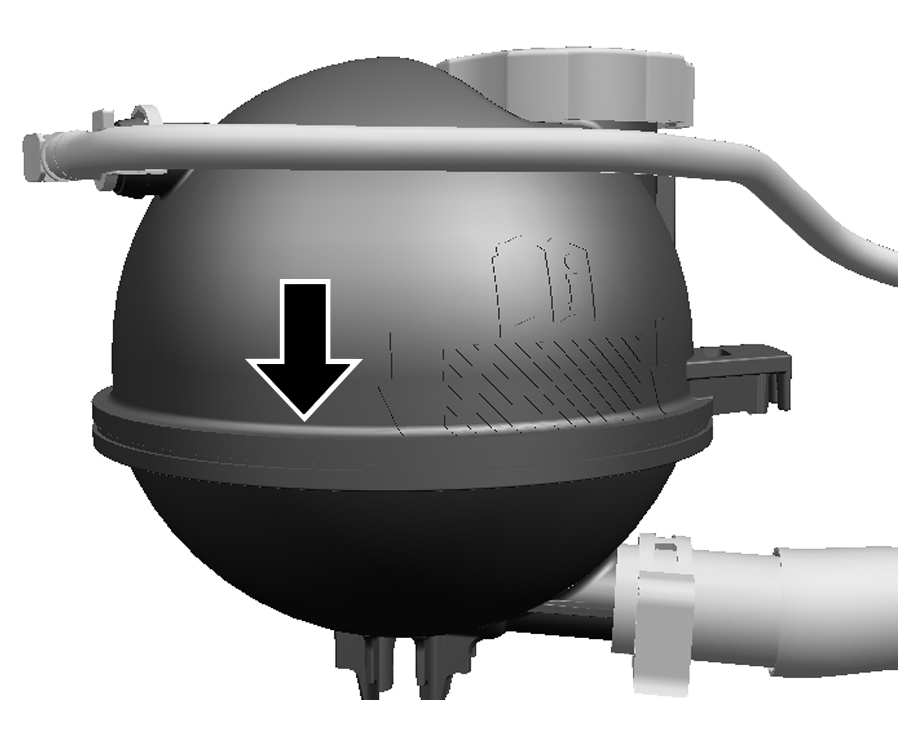
- Fill the coolant surge tank with the proper mixture to the indicated level mark.
- With the coolant surge tank pressure cap off, start the engine and let it run until you can feel the upper radiator hose getting hot. Watch out for the engine cooling fan.
By this time, the coolant level inside the coolant surge tank may be lower. If the level is lower, add more of the proper mixture to the coolant surge tank until the level reaches the indicated
level mark. - Replace the pressure cap tightly.
- Verify coolant level after the engine is shut off and the coolant is cold.
If necessary, repeat coolant fill procedure Steps 1–6.
If the coolant still is not at the proper level when the system cools down again, see your dealer.
Caution
If the pressure cap is not tightly installed, coolant loss and engine damage may occur. Be sure the cap is properly and tightly secured.
Automatic Coolant Service Fill Instruction
If equipped, this feature assists in filling and removing air from the cooling system after service of components or when coolant is added after being too low.
To activate the fill and air removal process:
- With a cold system, open the surge tank cap and add coolant to the indicated mark on the surge tank.
- Connect the vehicle to a battery charger.
- Turn the ignition to Service See Ignition Positions page 193.
- Turn off the air conditioning.
- Set the parking brake.
- At the same time, press the accelerator and the brake for two seconds, then release.
At the end of the cycle, check the coolant level in the surge tank and add coolant if it is low. Turn off the vehicle, allow the Engine
Control Module (ECM) to go to sleep, about two minutes, and repeat Steps 3-7.
Listen for pump activation and movement of the control valves while watching the level of the coolant in the surge tank. If the tank empties, turn the ignition off, carefully remove the surge tank cap, refill to the indicated mark, and repeat Steps 4-7. The fill and air removal process will run for approximately 10 minutes.
Engine Overheating
The vehicle has several indicators to warn of the engine overheating.
There is an engine coolant temperature gauge on the instrument cluster. See Engine Coolant Temperature Gauge page 97 The vehicle may also display a message on the Driver Information Center (DIC).
If the decision is made not to lift the hood when this warning appears, get service help right away. See Roadside Assistance Program page 339 .
If the decision is made to lift the hood, make sure the vehicle is parked on a level surface.
Then check to see if the engine cooling fan is running. If the engine is overheating, the fan should be running. If it is not, do not continue to run the engine. Have the vehicle serviced.
Caution
Do not run the engine if there is a leak in the engine cooling system. This can cause a loss of all coolant and can damage the system and vehicle. Have any leaks fixed right away.
If Steam Is Coming from the Engine Compartment
Warning
Steam and scalding liquids from a hot cooling system are under pressure. Turning the pressure cap, even a little, can cause them to come out at high speed and you could be burned. Never turn the cap when the cooling system, including the pressure cap, is hot. Wait for the cooling system and pressure cap to cool.
If No Steam Is Coming from the Engine Compartment
If an engine overheat warning is displayed but no steam can be seen or heard, the problem may not be too serious. Sometimes the engine can get a little too hot when the vehicle:
- Climbs a long hill on a hot day.
- Stops after high-speed driving.
- Idles for long periods in traffic.
If the overheat warning is displayed with no sign of steam:
- Turn the air conditioning off.
- Turn the heater on to the highest temperature and to the highest fan Open the windows as necessary.
- When it is safe to do so, pull off the road, shift to P (Park) or N (Neutral), and let the engine idle.
If the engine coolant temperature gauge is no longer in the overheated area, the vehicle can be driven. Continue to drive the vehicle slowly for about 10 minutes. Keep a safe distance from the vehicle in front. If the warning does not come back on, continue to drive normally and have the cooling system checked for proper fill and function.
If the warning continues, pull over, stop, and park the vehicle right away.
If there is no sign of steam, idle the engine for three minutes while parked. If the warning is still displayed, turn off the engine until it cools down.
Washer Fluid
What to Use
When windshield washer fluid is needed, be sure to read the manufacturer’s instructions before use. If operating the vehicle in an area where the temperature may fall below freezing, use a fluid that has sufficient protection against freezing.
Adding Washer Fluid

Open the cap with the washer symbol on it. Add washer fluid until the tank is full. See Engine Compartment Overview page 260 for reservoir location .
Caution
- Do not use washer fluid that contains any type of water repellent coating. This can cause the wiper blades to chatter or skip.
- Do not use engine coolant (antifreeze) in the windshield washer. It can damage the windshield washer system and paint.
- Do not mix water with ready-to-use washer fluid. Water can cause the solution to freeze and damage the washer fluid tank and other parts of the washer system.
- When using concentrated washer fluid, follow the manufacturer instructions for adding water.
- Fill the washer fluid tank only three-quarters full when it is very cold. This allows for fluid expansion if freezing occurs, which could damage the tank if it is completely full.
Brakes
Disc brake linings have built-in wear indicators that make a high-pitched warning sound when the brake linings are worn and new linings are needed. The sound can come and go or can be heard all the time when the vehicle is moving, except when applying the brake pedal firmly.
Warning
The brake wear warning sound means that soon the brakes will not work well. That could lead to a crash. When the brake wear warning sound is heard, have the vehicle serviced.
Caution
Continuing to drive with worn-out brake linings could result in costly brake repairs.
Some driving conditions or climates can cause a brake squeal when the brakes are first applied, clearing up following several applications. This does not mean something is wrong with the brakes.
Properly torqued wheel nuts are necessary to help prevent brake pulsation. When tires are rotated, inspect brake linings for wear and evenly tighten wheel nuts in the proper sequence to torque specifications. See Capacities and Specifications page 333.
Brake pads should be replaced as complete axle sets.
Brake Pedal Travel
See your dealer if the brake pedal does not return to normal height, or if there is a rapid increase in pedal travel. This could be a sign that brake service may be required.
Replacing Brake System Parts
Always replace brake system parts with new, approved replacement parts. If this is not done, the brakes may not work properly. The braking performance can change in many ways if the wrong brake parts are installed or if parts are improperly installed.
Brake Pad Life System
When to Change Brake Pads
If equipped, this system estimates the remaining life of the front and rear brake pads. Brake pad life is displayed in the
Driver Information Center (DIC), along with a percentage for each axle. The system must be reset every time the brake pads are changed.
When the system has determined that the brake pads need to be replaced, a message will display.
Brake pads should always be replaced as complete axle sets.
How to Reset the Brake Pad Life System
When the ignition is turned on after new pads and wear sensors are installed, a message will display. Follow the prompts to reset the system.
The brake pad life system can also be manually reset:
- Display Brake Pad Life on the DIC. See
Driver Information Center (DIC) (Base Level) 0 108 or
Driver Information Center (DIC) (Uplevel) 110. - Press and hold l or the thumbwheel.
Select front or rear pads as appropriate. - Select YES on the confirmation message.
- Repeat for pads on the other axle if they were also replaced.
How to Disable the Brake Pad Life System
The brake pad life system can be turned off.
This may be necessary if aftermarket brake pads without wear sensors are installed.
When the system is turned off, the front and rear brake pad life percentages will not display. However, the built-in wear indicators that make a high-pitched warning sound when the brake pads are worn can still determine when the pads should be replaced. See Brakes page 266.
To turn off the brake pad life system:
- Display Brake Pad Life on the DIC. See
Driver Information Center (DIC) (Base Level) page 108 or
Driver Information Center (DIC) (Uplevel) page 110. - Select DISABLE
To turn the brake pad life system back on, follow the above steps but select ENABLE in Step 2.
Brake Fluid

The brake master cylinder reservoir is filled with GM approved DOT 4 brake fluid as indicated on the reservoir cap. See Engine Compartment Overview page 253 for the location of the reservoir.
Checking Brake Fluid
With the vehicle in P (Park) on a level surface, the brake fluid level should be between the minimum and maximum marks on the brake fluid reservoir.
There are only two reasons why the brake fluid level in the reservoir may go down:
- Normal brake lining wear. When new linings are installed, the fluid level goes back up.
- A fluid leak in the brake hydraulic system. Have the brake hydraulic system fixed.
- With a leak, the brakes will not work well.
Always clean the brake fluid reservoir cap and the area around the cap before removing it.
Do not top off the brake fluid. Adding fluid does not correct a leak. If fluid is added when the linings are worn, there will be too much fluid when new brake linings are installed. Add or remove fluid, as necessary, only when work is done on the brake hydraulic system .
Warning
If too much brake fluid is added, it can spill on the engine and burn, if the engine is hot enough. You or others could be burned, and the vehicle could be damaged. Add brake fluid only when work is done on the brake hydraulic system.
When the brake fluid falls to a low level, the brake warning light comes on. See Brake System Warning Light page 102 .
Brake fluid absorbs water over time which degrades the effectiveness of the brake fluid. Replace brake fluid at the specified intervals to prevent increased stopping distance. See Maintenance Schedule page 324.
What to Add
Use only GM approved DOT 4 brake fluid from a clean, sealed container. See Recommended Fluids and Lubricants page 328.
Warning
The wrong or contaminated brake fluid could result in damage to the brake system. This could result in the loss of braking leading to a possible injury. Always use the proper GM approved brake fluid.
Caution
If brake fluid is spilled on the vehicle’s painted surfaces, the paint finish can be damaged. Immediately wash off any painted surface.
Battery – North America
The original equipment battery is maintenance free. Do not remove the cap and do not add fluid.
Refer to the replacement number on the original battery label when a new battery is needed. For replacement of the battery, see your dealer.
The vehicle has an Absorbent Glass Mat (AGM) 12-volt battery. Installation of a standard 12-volt battery will result in reduced 12-volt battery life.
When using a 12-volt battery charger on the 12-volt AGM battery, some chargers have an AGM battery setting on the charger.
If available, use the AGM setting on the charger, to limit charge voltage to 14.8 volts.
Warning
WARNING: Battery posts, terminals and related accessories can expose you to chemicals including lead and lead compounds, which are known to the State of California to cause cancer and birth defects or other reproductive harm. Wash hands after handling. For more information go to www.P65Warnings.ca.gov.
See California Proposition 65 Warning page 1.
Vehicle Storage
Warning
Batteries have acid that can burn you and gas that can explode. You can be badly hurt if you are not careful. Always wear eye protection. See Jump Starting – North America page 309 for tips on working around a battery without getting hurt.
Infrequent Usage: Remove the black, negative (−) cable from the battery to keep the battery from running down.
Extended Storage: Remove the black, negative (−) cable from the battery or use a battery trickle charger.
Negative Battery Cable Disconnection
Warning
Before disconnecting the negative battery cable, turn off all features, turn the ignition off, and remove the key,
if equipped, from the vehicle. If this is not done, you or others could be injured, and the vehicle could be damaged.
Caution
If the battery is disconnected with the ignition on or the vehicle in Retained Accessory Power (RAP), the OnStar back-up battery will be permanently discharged and will need to be replaced.
- Make sure the lamps, features, and accessories are turned off.
- Turn the ignition off and remove the key, if equipped.

- Loosen the negative battery cable nut (1).
- Remove the negative battery cable (2) from the battery.
Negative Battery Cable Reconnection
Caution
When reconnecting the battery:
- Use the original nut from the vehicle to secure the negative battery cable. Do not use a different nut. If you need a replacement nut, see your dealer.
- Tighten the nut with a hand tool. Do not use an impact wrench or power tools to tighten the nut.
The vehicle could be damaged if these guidelines are not followed.
Caution
Do not use paints, lubricants, or corrosion inhibitors on the nut that secures the negative battery cable to the vehicle. This could damage the vehicle.
- Install the negative battery cable (2) to the battery.
- Install the negative battery cable nut (1) and tighten.
- Turn the ignition on.
All-Wheel Drive
Transfer Case
Under normal driving conditions, transfer case fluid does not require maintenance unless there is a fluid leak or unusual noise. If required, have the transfer case serviced by your dealer.
Automatic Transmission Shift Lock Control Function Check
Warning
When you are doing this inspection, the vehicle could move suddenly. If the vehicle moves, you or others could be injured.
- Before starting this check, be sure there is enough room around the vehicle.
It should be parked on a level surface. - Apply the parking brake. Be ready to apply the regular brake immediately if the vehicle begins to move.
- With the engine off, turn the ignition on, but do not start the engine. Without applying the regular brake, try to move the shift lever out of P (Park) with normal effort. If the shift lever moves out of P (Park), contact your dealer for service.
Park Brake and P (Park) Mechanism Check
Warning
When you are doing this check, the vehicle could begin to move. You or others could be injured and property could be damaged. Make sure there is room in front of the vehicle in case it begins to roll. Be ready to apply the regular brake at once should the vehicle begin to move.
Park on a fairly steep hill, with the vehicle facing downhill. Keeping your foot on the regular brake, set the parking brake.
- To check the parking brake’s holding ability: With the engine running and the transmission in N (Neutral), slowly remove foot pressure from the regular brake pedal. Do this until the vehicle is held by the parking brake only.
- To check the P (Park) mechanism’s holding ability: With the engine running, shift to P (Park). Then release the parking brake followed by the regular brake.
Contact your dealer if service is required.
Wiper Blade Replacement
Windshield wiper blades should be inspected for wear and cracking. See Maintenance Schedule page 324.
Replacement blades come in different types and are removed in different ways. For proper type and length, see Maintenance Replacement Parts page 324
Caution
Allowing the wiper arm to touch the windshield when no wiper blade is installed could damage the windshield. Any damage that occurs would not be covered by the vehicle warranty. Do not allow the wiper arm to touch the windshield.
Front Wiper Blade Replacement
To replace the front wiper blades:
- Pull the windshield wiper assembly away from the windshield.
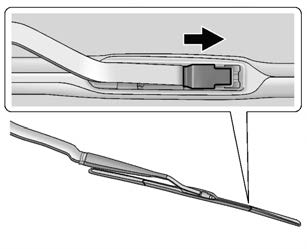
- Press the release button on the top side of the wiper and pull the wiper blade out of the end of the wiper arm.
- Install the wiper blade connector by sliding it into the end of the wiper arm until the button on the wiper blade clicks into place.
- Place the wiper arm and wiper blade back on the windshield.
Caution
Damage may occur if the wiper blades are not in contact with the windshield before turning on the wiper system.
Rear Wiper Blade Replacement
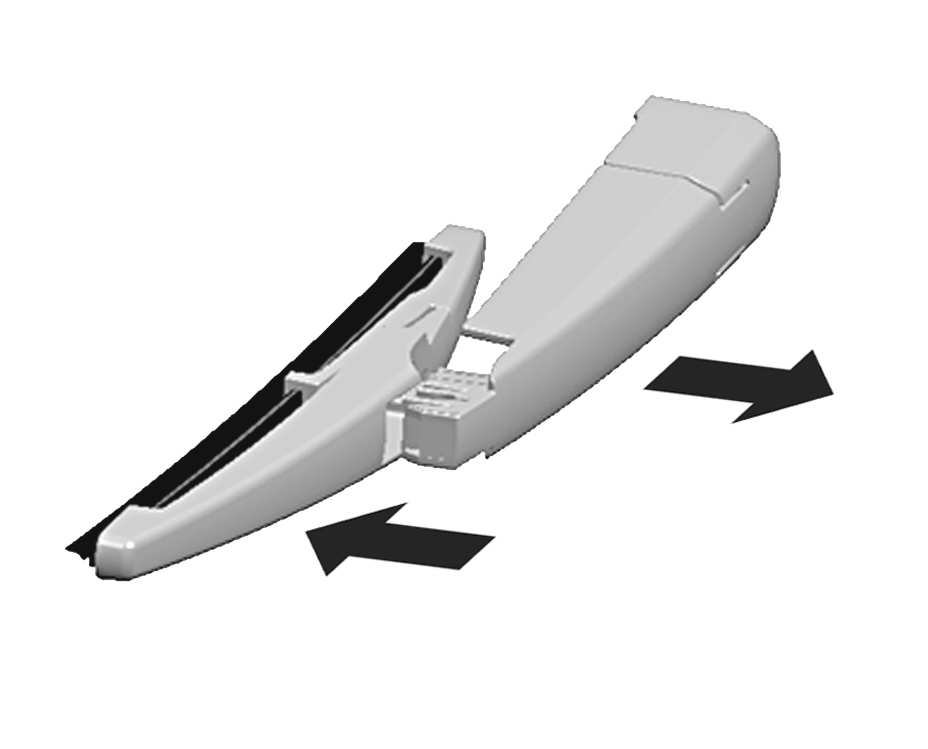
- Lift the wiper arm away from the rear windshield.
- Push the wiper blade away from the wiper arm.
- Once the blade pin disengages from the wiper arm, remove the wiper blade by sliding the blade off the arm.
- Reverse Steps 1–3 to install a new wiper blade.
Windshield Replacement
Driver Assistance Systems
When a windshield replacement is needed and the vehicle is equipped with a front-looking camera sensor for the Driver Assistance Systems, the windshield must be installed according to GM specifications for these systems to work properly. If it is not, there may be unexpected behavior and/or messages from these systems.
Gas Strut(s)
Your vehicle may be equipped with gas strut(s) to provide assistance in lifting and holding open the hood/trunk/liftgate system in full open position.
Warning
If the gas struts that hold open the hood, trunk, and/or liftgate fail, you or others could be seriously injured. Take the vehicle to your dealer for service immediately. Visually inspect the gas struts for signs of wear, cracks, or other damage periodically. Check to make sure the hood/trunk/liftgate is held open with enough force. If struts are failing to hold the hood/trunk/liftgate, do not operate. Have the vehicle serviced.
Caution
Do not apply tape or hang any objects from gas struts. Also do not push down or pull on gas struts. This may cause damage to the vehicle.
See Maintenance Schedule page 324.
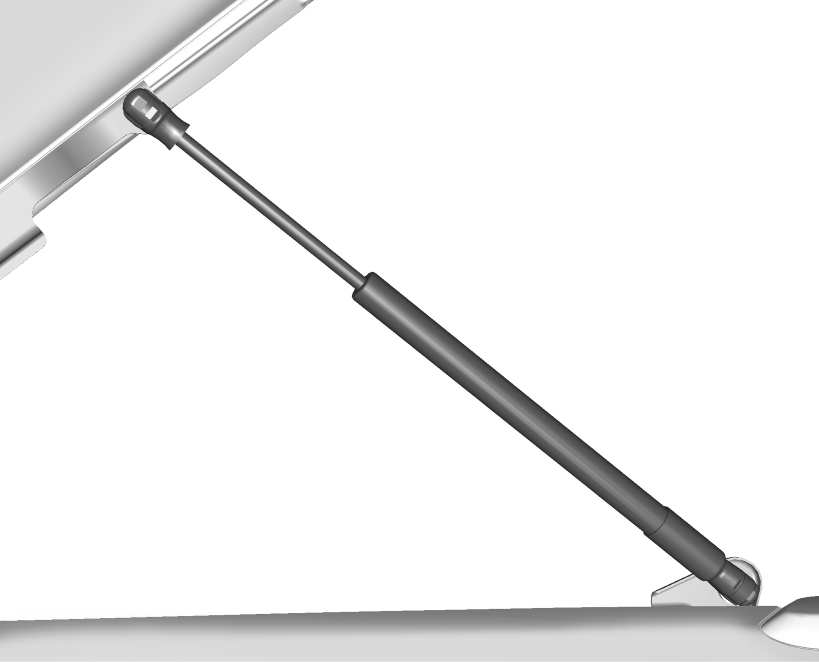
Hood

Trunk
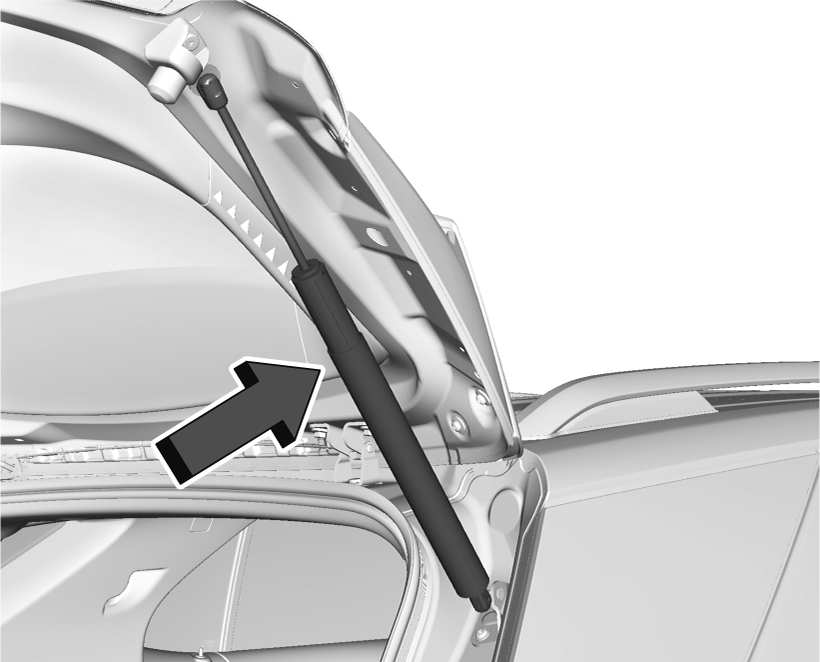
Liftgate
Headlamp Aiming
Front Headlamp Aiming
Headlamp aim h as been preset and should need no further adjustment.
If the vehicle is damaged in a crash, the headlamp aim may be affected.
If adjustment to the headlamps is necessary, see your dealer.
Bulb Replacement
For the proper type of replacement bulbs, or any bulb changing procedure not listed in this section, contact your dealer.
Caution
Do not replace incandescent bulbs with aftermarket LED replacement bulbs. This can cause damage to the vehicle electrical system.
This vehicle may be equipped with desiccant to reduce fogging inside the headlamp due to moisture. If fogging continues for a long time, see your dealer for service.
Halogen Bulbs
Warning
Halogen bulbs have pressurized gas inside and can burst if you drop or scratch the bulb. You or others could be injured. Be sure to read and follow the instructions on the bulb package.
LED Lighting
This vehicle has several LED lamps. For replacement of any LED lighting assembly, contact your dealer.
Headlamps and Sidemarker Lamps
Base Level Headlamp Assembly The base model vehicle has halogen high-beam and low-beam headlamps, an LED turn signal lamp, and a DRL and parking lamp on the headlamp assembly.

Driver Side Shown, Passenger Side Similar
- Low-Beam Headlamp
- High-Beam Headlamp
High-Beam Headlamp/Low-Beam Headlamp
- Open the hood. See Hood page 251.

- Remove the headlamp bulb access cover.
- Turn the bulb counterclockwise and pull straight back.

- Disconnect the wiring harness connector from the bulb.
- Install the new bulb in the headlamp assembly by turning clockwise.
- Reconnect the wiring harness connector.
- Install the headlamp bulb access cover.
Uplevel Headlamp Assembly
The uplevel model vehicle has LED
high-beam and low-beam headlamps, a DRL and parking lamp, and a DRL position lamp on the headlamp assembly.
Sidemarker
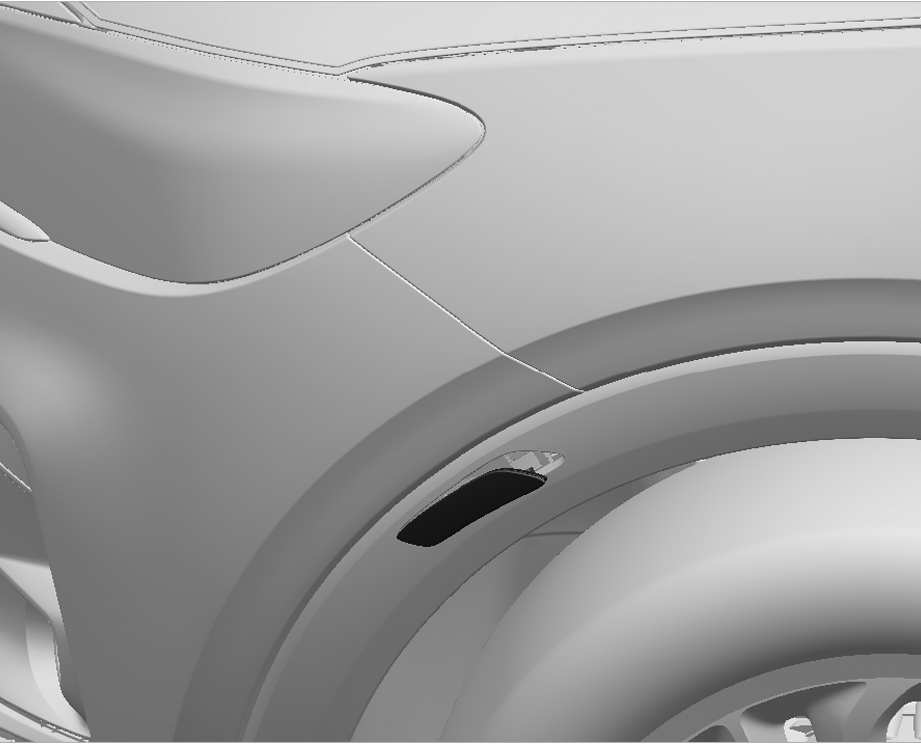
The vehicle has an LED sidemarker lamp.
Front Turn Signal and Fog Lamps
Front Turn Signal Lamp

Driver Side Shown, Passenger Side Similar
- Tilt the wheel and remove the screws on the outside of the wheel liner.

- Bend the wheel liner back to make enough space for hand access.

- While holding the wheel liner with one hand and disengage the bulb socket from the plug connector by pulling the retaining rib.
- Turn the bulb holder counterclockwise and remove it from the reflector using the other hand.
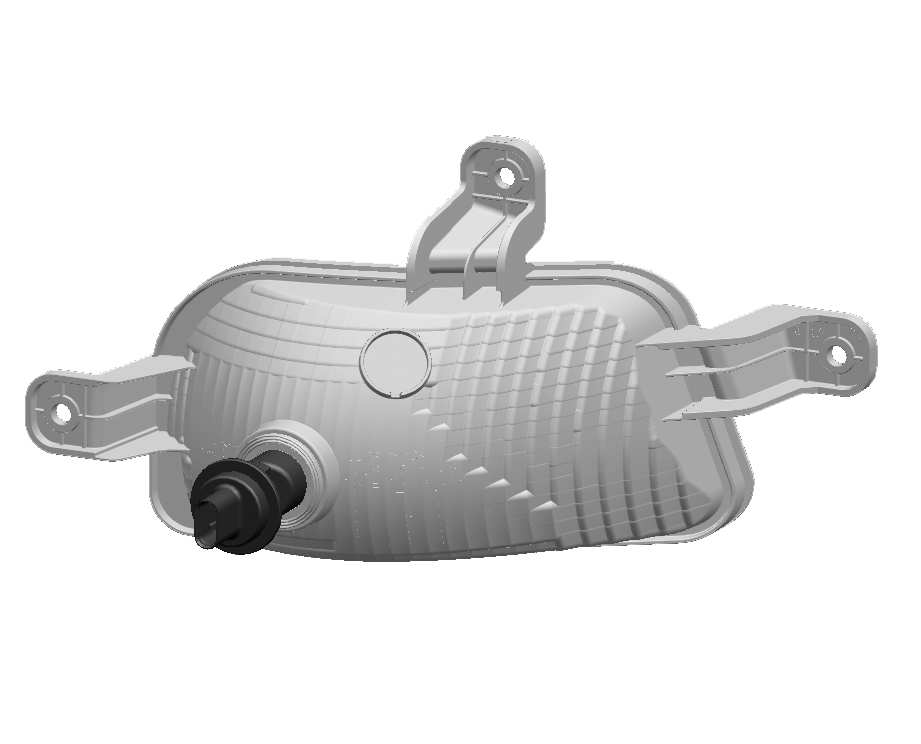
- Remove the bulb from the bulb socket and replace with a new bulb.
- Insert the bulb socket into the reflector by turning clockwise and attach the plug connector.
Reassemble the lower cover and front wheel liner.
Front Fog Lamp
The vehicle has LED fog lamp Taillamps, Turn Signal, Sidemarker, Stop lamps, and Back-Up Lamps (Base Level)
Caution
Improper lamp assembly removal and installation can cause leaks and water intrusion which may cause damage to the taillamp. Do not remove the taillamp assembly to replace a bulb. Use the tailgate opening to access the bulb.
Tailgate inboard Taillamp
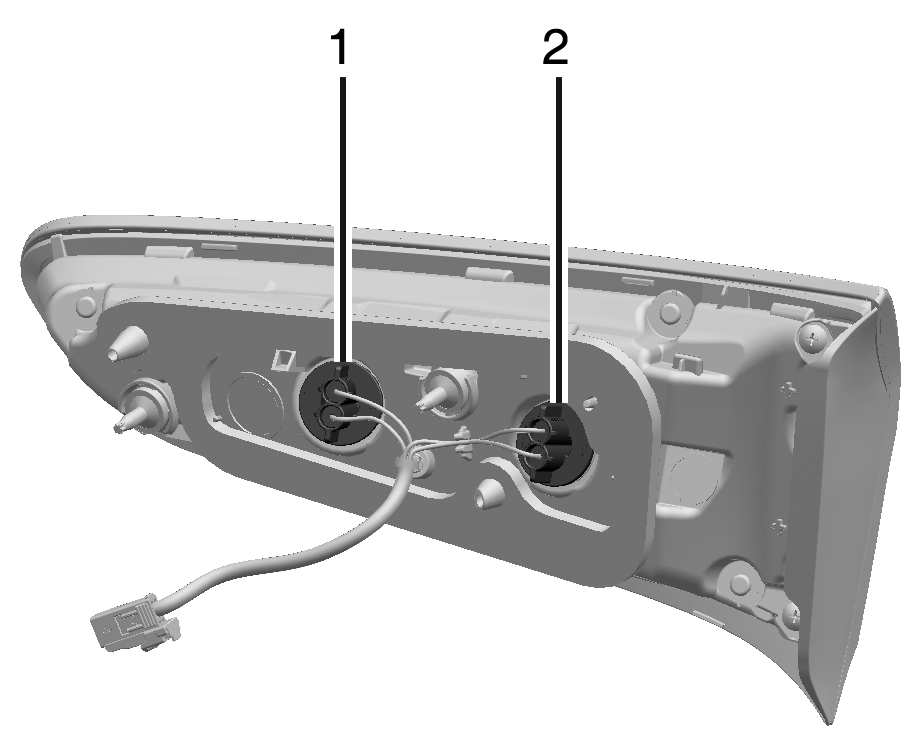
Driver Side Shown, Passenger Side Similar
- Taillamp
- Taillamp
- Remove the bulb access door on tailgate.
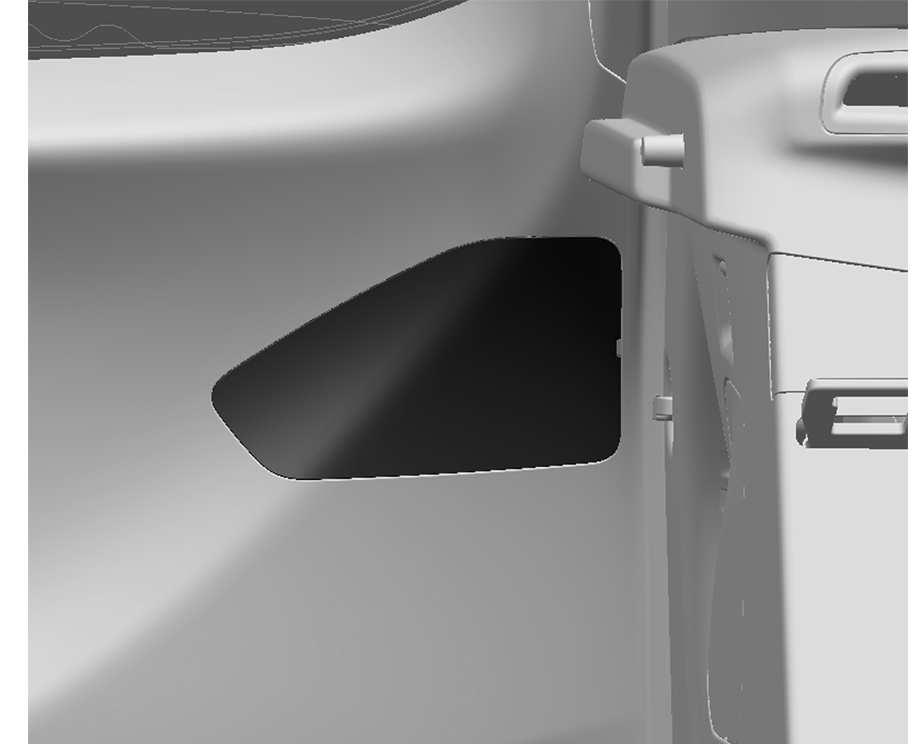
- Remove the bulb from the bulb socket and replace with a new bulb.

- Insert the bulb socket and attach the plug connector.
- Reassemble the cover.
Stop lamp/Taillamp, Turn Signal, and Sidemarker Lamp

Driver Side Shown, Passenger Side Similar
- Stop lamp/Taillamp
- Turn signal lamp
- Remove and retain both screws attaching the taillamp assembly to the vehicle body.
- Pull the taillamp assembly straight back to detach it from the vehicle body. Take care that the cable duct remains in place.

- Remove the bulb socket from the taillamp assembly.

- Remove the old bulb from the bulb socket by pulling it straight out.
- Insert a new bulb into the bulb socket.
- Install the bulb socket into the taillamp assembly.
- Install the taillamp assembly to the vehicle body with the two screws.
Rear Back-Up Lamp
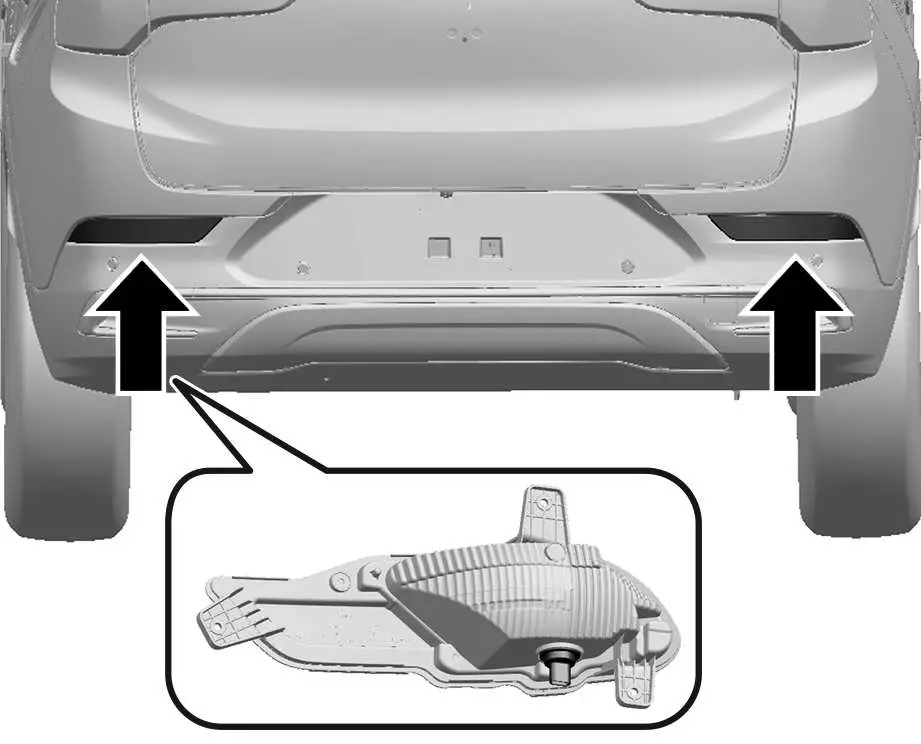
The bulbs are accessible from the underside
of the vehicle.
- Turn the bulb holder anti-clockwise and remove it from reflector.

- Disengage the bulb socket from the plug connector by pressing the retaining lug.
- Remove and replace the bulb socket with bulb and attach the plug connector.
- Insert the bulb socket into the reflector and turn clockwise to engage.
Taillamps, Turn Signal, Sidemarker, Stoplamps, and Back-Up Lamps (Uplevel)
Caution
Improper lamp assembly removal and installation can cause leaks and water intrusion which may cause damage to the taillamp. Do not remove the taillamp assembly to replace a bulb. Use the tailgate opening to access the bulb.
The stoplamp/taillamp/turn signal lamp/side marker lamp and tailgate inboard taillamp are LEDs. To replace, see your dealer.
Electrical System
Electrical System Overload
The vehicle has fuses and circuit breakers to protect against an electrical system overload.
When the current electrical load is too heavy, the circuit breaker opens and closes, protecting the circuit until the current load returns to normal or the problem is fixed. This greatly reduces the chance of circuit overload and fire caused by electrical problems.
Fuses and circuit breakers protect power devices in the vehicle.
If there is a problem on the road and a fuse needs to be replaced, the same amperage fuse can be borrowed. Choose some feature of the vehicle that is not needed to use and replace it as soon as possible.
To check a fuse, look at the band inside the fuse. If the band is broken or melted, replace the fuse. Be sure to replace a bad fuse with a fuse of the identical size and rating .


Replacing a Blown Fuse
- Turn off the vehicle .
- Locate the fuse puller in the engine compartment fuse block .
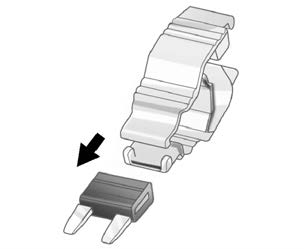

- Use the fuse puller to remove the fuse from the top or side, as shown above.
- If the fuse must be replaced immediately, borrow a replacement fuse with the same amperage from the fuse block. Choose a vehicle feature that is not needed to safely operate the Repeat Steps 2-3.
- Insert the replacement fuse into the empty slot of the blown fuse.
At the next opportunity, see your dealer to replace the blown fuse.
Headlamp Wiring
An electrical overload may cause the lamps to go on and off, or in some cases to remain off. Have the headlamp wiring checked right away if the lamps go on and off or remain off.
Windshield Wipers
If the wiper motor overheats due to heavy snow or ice, the windshield wipers will stop until the motor cools and will then restart.
Although the circuit is protected from electrical overload, overload due to heavy snow or ice may cause wiper linkage damage. Always clear ice and heavy snow from the windshield before using the windshield wipers.
If the overload is caused by an electrical problem and not snow or ice, be sure to get it fixed.
Fuses and Circuit Breakers
The wiring circuits in the vehicle are protected from short circuits by a combination of fuses and circuit breakers. This greatly reduces the chance of damage caused by electrical problems.
Danger
Fuses and circuit breakers are marked with their ampere rating. Do not exceed the specified amperage rating when replacing fuses and circuit breakers. Use of an oversized fuse or circuit breaker can result in a vehicle fire. You and others could be seriously injured or killed.

Warning
Installation or use of fuses that do not meet GM’s original fuse specifications is dangerous. The fuses could fail, and result in a fire. You or others could be injured or killed, and the vehicle could be damaged.
See Accessories and Modifications page 250 and General Information page 250.
To check or replace a blown fuse, see Electrical System Overload page 278.
Engine Compartment Fuse Block
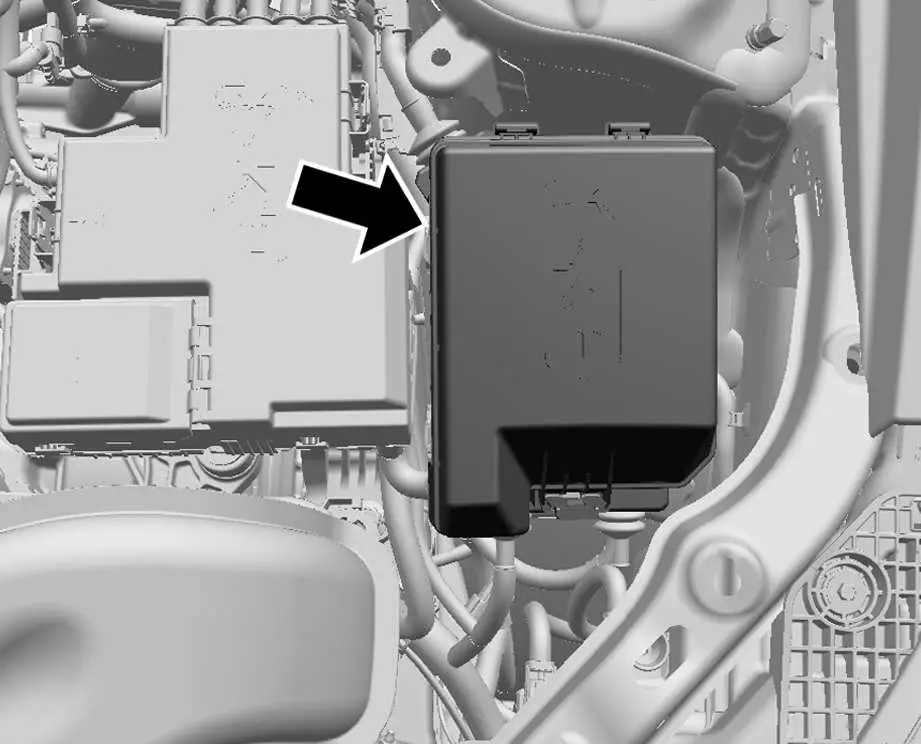
To remove the fuse block cover, squeeze the clip and lift it up.
Caution
Spilling liquid on any electrical component on the vehicle may damage it. Always keep the covers on any electrical component.
To remove fuses, use the fuse puller and pull straight out.
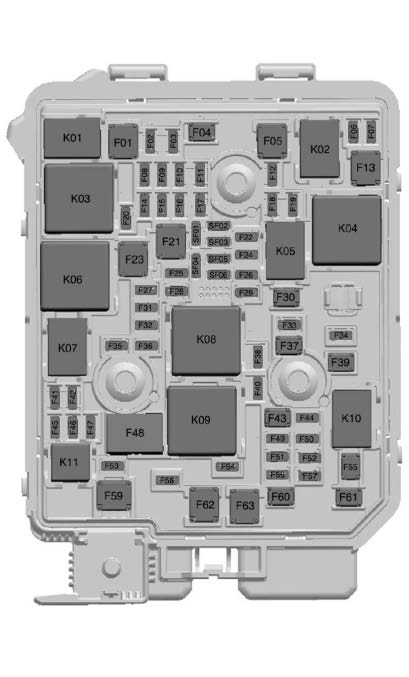
The vehicle may not be equipped with all of the fuses, relays, and features shown.
| Micro Fuses | Usage |
| F02 | CLSTR |
| F03 | N/A |
| F06 | OSRVM DEFOG |
| F07 | L/GATE RELSE |
| F08 | AHL AFL MTR1 |
| F09 | VENT SEAT |
| F10 | N/A |
| F11 | AHL AFL MTR2 |
| F12 | N/A |
| F14 | ISRVM REAR VIEW CAMERA |
| F15 | DEFC MDL RUN/CRNK |
| F16 | HDLP LVL |
| F17 | N/A-DSL |
| F18 | FTZM |
| F19 | N/A |
| F20 | N/A |
| F22 | TRLR ST/TRN LT – TRLR |
| F24 | ESCL |
| Micro Fuses | Usage |
| F25 | ECM TCM RUN/CRNK |
| F26 | FRT/REAR WSW PUMP |
| F27 | IGN COIL-GAS ECM PT3-DSL |
| F28 | AERO SH |
| F29 | AHL AFL MDL |
| F31 | ECM PT2 |
| F32 | ENG COMP2 |
| F33 | RVC |
| F34 | FRT FOG LP |
| F35 | ENG COMP1 |
| F36 | ECM PT1 |
| F38 | TRLR PRK LAMP – TRLR |
| F40 | AUX WATER PUMP |
| F41 | REAR WPR |
| F42 | HORN |
| F44 | REAR WPR PRK |
| F45 | A/C CLTCH |
| F46 | N/A |
| Micro Fuses | Usage |
| F47 | ECM BATT-GAS ECM BATT-DSL |
| F49 | HDLP HI LH |
| F50 | N/A |
| F51 | HDLP HI RH |
| F52 | NOX SOOT SNSR -DSL TRLR ST/TRN RT – TRLR |
| F53 | N/A |
| F54 | PEPS |
| F56 | CNSTR VENT SOL-GAS/DEFC MDL-DSL |
| F57 | DEFC MDL-DSL |
| F58 | TCM BATT |
| Spare Fuses | Usage |
| SF06 | SPARE |
| ET Fuses | Usage |
| F48 | GLOW PLUG |
| J-Case Fuses | Usage |
| F01 | N/A |
| F05 | N/A |
| F13 | REAR WNDW DEFOG |
| F21 | E-BOOST PWR1 |
| F23 | STRTR PINION |
| F59 | N/A |
| F62 | FUEL HTR DSL |
| F63 | N/A |
| M-case Fuses | Usage |
| F04 | FRT WPR |
| F30 | STRTR SOL |
| F37 | AUX OIL PUMP |
| F39 | N/A |
| M-case Fuses | Usage |
| F43 | PWR WNDW RT |
| F55 | PWR WNDW LT |
| F60 | DEF HTR |
| F61 | N/A |
| Mini Relays | Usage |
| K03 | RUN/CRNK |
| K04 | REAR DEFOG |
| K06 | STRTR PINION |
| K08 | PT RLY |
| K09 | FUEL HTR DSL |
| HC Micro Relays |
Usage |
| K01 | N/A |
| K02 | N/A |
| K05 | STRTR SOL |
| K07 | A/C CNTRL |
| K10 | N/A |
| Ultra Micro Relays |
Usage |
| K11 | N/A |
Type 2 Fuse Block
| Micro Fuses | Usage |
| F02 | CLSTR |
| F03 | N/A |
| F06 | OSRVM DEFOG |
| F07 | L/GATE RELSE |
| F08 | N/A |
| F09 | VENT SEAT |
| F10 | N/A |
| F11 | N/A |
| F12 | N/A |
| F14 | ISRVM REAR VIEW CAMERA |
| F15 | N/A |
| F16 | HDLP LVL |
| F17 | N/A |
| F18 | FTZM |
| F19 | N/A |
| Micro Fuses | Usage |
| F20 | N/A |
| F22 | TRLR ST/TRN LT – TRLR |
| F24 | ESCL |
| F25 | ECM TCM RUN/CRNK |
| F26 | FRT/REAR WSW PUMP |
| F27 | IGN COIL-GAS |
| F28 | AERO SH |
| F29 | AHL AFL MDL |
| F31 | ECM PT2 |
| F32 | ENG COMP2 |
| F33 | RVC |
| F34 | FRT FOG LP |
| F35 | ENG COMP1 |
| F36 | ECM PT1 |
| F38 | TRLR PRK LAMP – TRLR |
| F40 | N/A |
| F41 | REAR WPR |
| F42 | HORN |
| F44 | REAR WPR PRK |
| Micro Fuses | Usage |
| F45 | A/C CLTCH |
| F46 | N/A |
| F47 | ECM BATT-GAS |
| F49 | HDLP HI LH |
| F50 | N/A |
| F51 | HDLP HI RH |
| F52 | TRLR ST/TRN RT – TRLR |
| F53 | AUX WATER PUMP |
| F54 | PEPS |
| F56 | CNSTR VENT SOL-GAS/DEFC |
| F57 | N/A |
| F58 | TCM BATT |
| Spare Fuses | Usage |
| SF01 | SPARE |
| SF02 | SPARE |
| SF03 | SPARE |
| SF04 | SPARE |
| SF05 | SPARE |
| Spare Fuses | Usage |
| SF06 | SPARE |
| ET Fuses | Usage |
| F48 | N/A |
| J-Case Fuses | Usage |
| F01 | N/A |
| F05 | N/A |
| F13 | REAR WNDW DEFOG |
| F21 | E-BOOST PWR1 |
| F23 | STRTR PINION |
| F59 | N/A |
| F62 | N/A |
| F63 | N/A |
| M-Case Fuses | Usage |
| F04 | FRT WPR |
| F30 | STRTR SOL |
| F37 | AUX OIL PUMP |
| F39 | N/A |
| M-Case Fuses | Usage |
| F43 | PWR WNDW RT |
| F55 | PWR WNDW LT |
| F60 | N/A |
| F61 | N/A |
| Mini Relays | Usage |
| K03 | RUN/CRNK |
| K04 | REAR DEFOG |
| K06 | STRTR PINION |
| K08 | PT RLY |
| K09 | N/A |
| HC Micro Relays |
Usage |
| K01 | N/A |
| K02 | N/A |
| K05 | STRTR SOL |
| K07 | A/C CNTRL |
| K10 | N/A |
| Ultra Micro Relays |
Usage |
| K11 | N/A |
Instrument Panel Fuse Block

The instrument panel fuse block is on the underside of the driver side instrument panel. To access the fuses, open the fuse cover by pulling out. To reinstall the cover, insert the top tab first, then push the cover back into its original location.
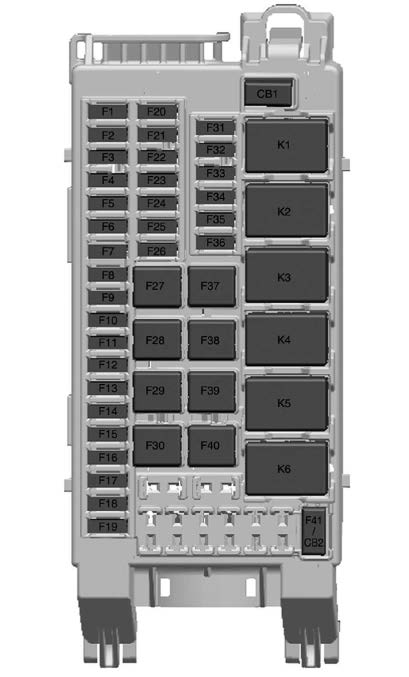
| Fuse | Usage |
| F01 | LUMBAR |
| F02 | SUNROOF |
| Fuse | Usage |
| F03 | VBAT_3 |
| F04 | VBAT_7 |
| F05 | VBAT_6 |
| F06 | AUTO HVAC |
| F07 | CGM |
| F08 | ST_WHL_HTR |
| F09 | DISPLAY |
| F10 | RADIO |
| F11 | ONSTAR (ERA) |
| F12 | PARK_ASSIST |
| F13 | MAN. HVAC |
| F14 | WL CHARGER |
| F15 | VBAT_2 |
| F16 | VBAT_1 |
| F17 | SWC BKLT |
| F18 | N/A |
| F19 | N/A |
| F20 | CLOCK SPRING |
| F21 | OCC SEN |
| Fuse | Usage |
| F22 | DLC |
| F23 | SDM |
| F24 | IGN_SW/ESCL |
| F25 | PWR L-GATE MDL |
| F26 | SEC FUSE-2 |
| F27 | PWR SEAT CO-DR |
| F28 | VBAT_8 |
| F29 | DC-DC AT |
| F30 | PWR L-GATE MDL |
| F31 | OSRVM |
| F32 | FRT HS PWR-1 |
| F33 | VBAT_4 |
| F34 | FRT HS PWR-2 |
| F35 | AMPLIFIER |
| F36 | ONSTAR (TCP) |
| F37 | PWR SEAT DR |
| F38 | DC-DC_400W |
| F39 | SEC FUSE-1 |
| F40 | HVAC_BLOWER |
| Circuit Breaker |
Usage |
| CB1 | N/A |
| CB2 | APO |
| Relay | Usage |
| K01 | i-RAP_ACC |
| K02 | RUN |
| K03 | LOGISTICS |
| K04 | N/A |
| K05 | N/A |
| K06 | N/A |
Rear Compartment Fuse Block
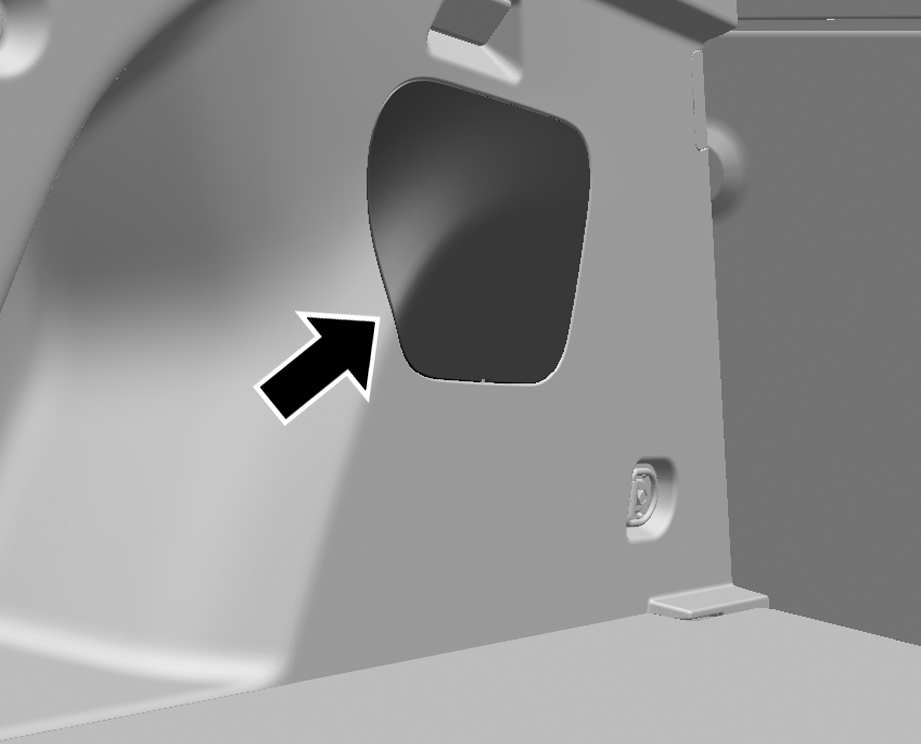
The rear compartment fuse block is behind a cover on the driver side of the rear] compartment. To access the fuses, remove the cover.
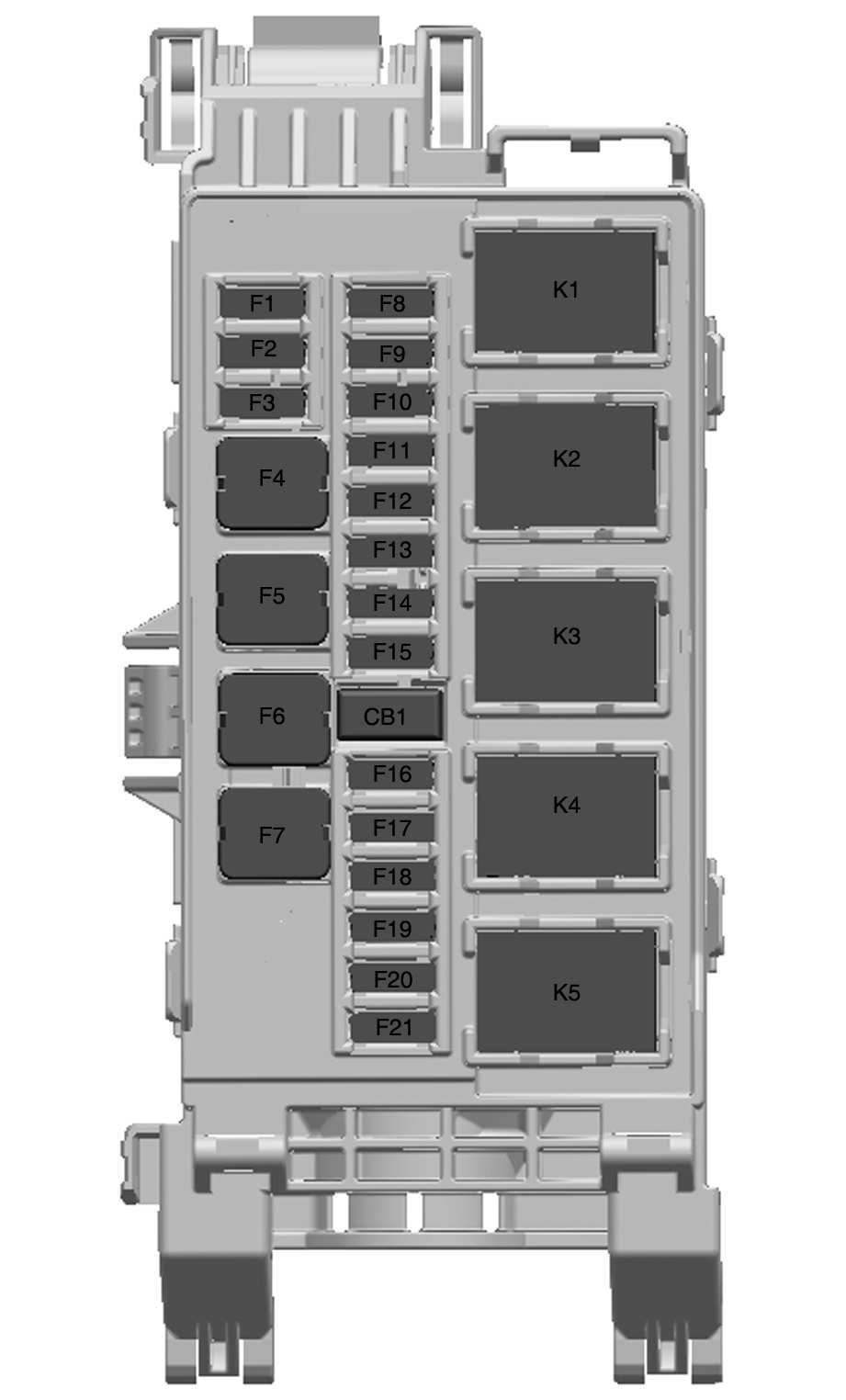
| Fuse | Usage |
| F01 | N/A |
| F02 | RDCM ELEC |
| Fuse | Usage |
| F03 | N/A |
| F04 | N/A |
| F05 | DC/AC INVERTER |
| F06 | N/A |
| F07 | RDCM |
| F08 | RR SEAT HEAT PWR1 |
| F09 | N/A |
| F10 | RR SEAT HEAT PWR2 |
| F11 | N/A |
| F12 | N/A |
| F13 | N/A |
| F14 | N/A |
| F15 | N/A |
| F16 | N/A |
| F17 | N/A |
| F18 | N/A |
| F19 | N/A |
| F20 | N/A |
| F21 | N/A |
| Circuit Breakers |
Usage |
| CB1 | N/A |
| Relays | Usage |
| K01 | N/A |
| K02 | N/A |
| K03 | N/A |
| K04 | N/A |
| K05 | N/A |
Wheels and Tires
Tires
Every new GM vehicle has high-quality tires made by a leading tire manufacturer. See the warranty manual for information regarding the tire warranty and where to get service. For additional information refer to the tire manufacturer.
Warning
- Poorly maintained and improperly used tires are dangerous.
- Overloading the tires can cause overheating as a result of too much flexing. There could be a blowout and a serious crash. See Vehicle Load Limits page 190.
- Underinflated tires pose the same danger as overloaded tires. The resulting crash could cause serious Check all tires frequently to maintain the recommended pressure. Tire pressure should be checked when the tires are cold.
- Overinflated tires are more likely to be cut, punctured, or broken by a sudden impact — such as when hitting a pothole. Keep tires at the recommended pressure.
- Worn or old tires can cause a crash. If the tread is badly worn, replace them.
- Replace any tires that have been damaged by impacts with potholes, curbs, etc.
- Improperly repaired tires can cause a crash. Only your dealer or an authorized tire service center should repair, replace, dismount, and mount the tires.
- Do not spin the tires in excess of 56 km/h (35 mph) on slippery surfaces such as snow, mud, ice, Excessive spinning may cause the tires to explode.
All-Season Tires
This vehicle may come with all-season tires These tires are designed to provide good overall performance on most road surfaces and weather conditions. Original equipment tires designed to GM’s specific tire performance criteria have a TPC specification code molded onto the sidewall. Original equipment all-season tires can be identified by the last two characters of this TPC code, which will be “MS.”
Consider installing winter tires on the vehicle if frequent driving on snow or ice-covered roads is expected. All-season tires provide adequate performance for most winter driving conditions, but they may not offer the same level of traction or performance as winter tires on snow or ice-covered roads. See Winter Tires page 288.
Winter Tires
This vehicle was not originally equipped with winter tires. Winter tires are designed for increased traction on snow and ice-covered roads. Consider installing winter tires on the vehicle if frequent driving on ice or snow covered roads is expected. See your dealer for details regarding winter tire availability and proper tire selection. Also, see Buying New Tires page 299
With winter tires, there may be decreased dry road traction, increased road noise, and shorter tread life. After changing to winter tires, be alert for changes in vehicle handling and braking.
If using winter tires:
- Use tires of the same brand and tread type on all four wheel positions.
- Use only radial ply tires of the same size, load range, and speed rating as the original equipment tires.
Winter tires with the same speed rating as the original equipment tires may not be available for H, V, W, Y, and ZR speed rated tires. If winter tires with a lower speed rating are chosen, never exceed the tire’s maximum speed capability.
Tire Sidewall Labeling
Useful information about a tire is molded into its sidewall. The examples show a typical passenger vehicle tire and a compact spare tire sidewall.
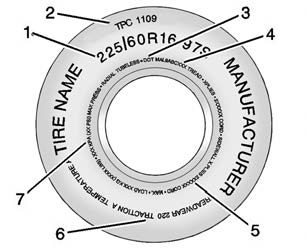
Passenger Tire Example
- Tire Size : The tire size is a combination of letters and numbers used to define a particular tire’s width, height, aspect ratio, construction type, and service description. See the “Tire Size” illustration in this section.
- TPC Spec (Tire Performance Criteria Specification) : Original equipment tires designed to GM’s specific tire performance criteria have a TPC specification code molded onto the sidewall. GM’s TPC specifications meet or exceed all federal safety guidelines.
- DOT (Department of Transportation) : The Department of Transportation (DOT) code indicates that the tire is in compliance with the U.S. Department of Transportation Motor Vehicle Safety Standards.
- DOT Tire Date of Manufacture : The last four digits of the TIN indicate the tire manufactured date. The first two digits represent the week and the last two digits, the year. For example, the third week of the year 2020 would have a 4-digit DOT date of 0320. Week 01 is the first full week (Sunday through Saturday) of each year.
- Tire Identification Number (TIN) :
The letters and numbers following the DOT (Department of Transportation) code are the Tire Identification Number (TIN). The TIN shows the manufacturer and plant code, tire size, and date the tire was manufactured. The TIN is molded onto both sides of the tire, although only one side may have the date of manufacture. - Tire Ply Material : The type of cord and number of plies in the sidewall and under the tread.
- Uniform Tire Quality Grading (UTQG) : Tire manufacturers are required to grade tires based on three performance factors: tread wear, traction, and temperature resistance. For more information see Uniform Tire Quality Grading page 301.

Compact Spare Tire Example
- Tire Ply Material : The type of cord and number of plies in the sidewall and under the tread.
- Temporary Use Only : The compact spare tire or temporary use tire should not be driven at speeds over 80 km/h (50 mph). The compact spare tire is for emergency use when a regular road tire has lost air and gone flat. If the vehicle has a compact spare tire, see Compact Spare Tire page 308 and If a Tire Goes Flat page 303.
-
- Tire Identification Number (TIN) : The letters and numbers following the DOT (Department of Transportation) code are the Tire Identification Number (TIN). The TIN shows the manufacturer and plant code, tire size, and date the tire was manufactured. The TIN is molded onto both sides of the tire, although only one side may have the date of manufacture.
- Maximum Cold Inflation Load Limit : Maximum load that can be carried and the maximum pressure needed to support that load.
- Tire Inflation : The temporary use tire or compact spare tire should be inflated to 420 kPa (60 psi). For more information on tire pressure and inflation see Tire Pressure page 292
- Tire Size : A combination of letters and numbers define a tire’s width, height, aspect ratio, construction type, and service description. The letter “T” as the first character in the tire size means the tire is for temporary use only.
- TPC Spec (Tire Performance Criteria Specification) : Original equipment tires designed to GM’s specific tire performance criteria have a TPC specification code molded onto the GM’s TPC specifications meet or exceed all federal safety guidelines.
Tire Designations
Tire Size
The example shows a typical passenger vehicle tire size.

Passenger (P-Metric) Tire
- Passenger (P-Metric) Tire : The United States version of a metric tire sizing system. The letter “P” as the first character in the tire size means a passenger vehicle tire engineered to standards set by the U.S. Tire and Rim
- Tire Width : The 3-digit number indicates the tire section width in millimeters from sidewall to sidewall.
- Aspect Ratio : A 2-digit number that indicates the tire height-to-width measurements. For example, if the tire size aspect ratio is 75, as shown in item (3) of the illustration, it would mean that the tire’s sidewall is 75 percent as high as it is wide.
- Construction Code : A letter code is used to indicate the type of ply construction in the tire. The letter “R” means radial ply construction; the letter “D” means diagonal or bias ply construction .
- Rim Diameter : Diameter of the wheel in inches.
- Service Description : These characters represent the load index and speed rating of the tire. The load index represents the load carrying capacity a tire is certified to carry. The speed rating is the maximum speed a tire is certified to carry a load.
- Belt : A rubber coated layer of cords that is located between the plies and the tread. Cords may be made from steel or other reinforcing materials.
Bead : The tire bead contains steel wires wrapped by steel cords that hold the tire onto the rim.
Bias Play Tire : A pneumatic tire in which the plies are laid at alternate angles less than 90 degrees to the centerline of the tread.
Cold Tire Pressure : The amount of air pressure in a tire, measured in kPa (kilopascal) or psi (pounds per square inch) before a tire has built up heat from driving. See Tire Pressure page 292.
DOT Markings : A code molded into the sidewall of a tire signifying that the tire is in compliance with the U.S. Department of Transportation (DOT) Motor Vehicle Safety Standards. The DOT code includes the Tire Identification Number (TIN), an alphanumeric designator which can also identify the tire manufacturer, production plant, brand, and date of production.
GVWR : Gross Vehicle Weight Rating. See Vehicle Load Limits page 190 . - GAWR FRT : Gross Axle Weight Rating for the front axle. See Vehicle Load Limits page 190.
- GAWR RR : Gross Axle Weight Rating for the rear axle. See Vehicle Load Limits page 190.Intended Outboard Sidewall : The side of an asymmetrical tire, that must always face outward when mounted on a vehicle.Kilopascal (kPa) : The metric unit for air pressure.Light Truck (LT-Metric) Tire : A tire used on light duty trucks and some multipurpose passenger vehicles.Load Index : An assigned number ranging from 1 to 279 that corresponds to the load carrying capacity of a tire.Maximum Inflation Pressure : The maximum air pressure to which a cold tire can be inflated. The maximum air pressure is molded onto the sidewall.Maximum Load Rating : The load rating for a tire at the maximum permissible inflation pressure for that tire.Occupant Distribution : Designated seating positions.
Outward Facing Sidewall : The side of an asymmetrical tire that has a particular side that faces outward when mounted on a vehicle. The side of the tire that contains a whitewall, bears white lettering, or bears manufacturer, brand, and/or model name molding that is higher or deeper than the same moldings on the other sidewall of the tire.
Passenger (P-Metric) Tire : A tire used on passenger cars and some light duty trucks and multipurpose vehicles.
Recommended Inflation Pressure : Vehicle manufacturer’s recommended tire inflation pressure as shown on the tire placard. See Tire Pressure page 92 and Vehicle Load Limits page 190.
- Radial Ply Tire: A pneumatic tire in which the ply cords that extend to the beads are laid at 90 degrees to the centerline of the tread.
Rim: A metal support for a tire and upon which the tire beads are seated.
Sidewall: The portion of a tire between the tread and the bead.
Speed Rating: An alphanumeric code assigned to a tire indicating the maximum speed at which a tire can operate. - Traction: The friction between the tire and the road surface. The amount of grip provided.
Tread: The portion of a tire that comes into contact with the road. - Treadwear Indicators: Narrow bands, sometimes called wear bars, that show across the tread of a tire when only 1.6 mm (1/16 in) of tread remains. See When It Is Time for New Tires page 298 UTQGS (Uniform Tire Quality Grading Standards): A tire information system that provides consumers with ratings for a tire’s traction, temperature, and treadwear. Ratings are determined by tire manufacturers using government testing procedures. The ratings are molded into the sidewall of the tire. See Uniform Tire Quality Grading page 301.Vehicle Capacity Weight : The number of designated seating positions multiplied by 68 kg (150 lbs) plus the rated cargo load. See Vehicle Load Limits page 190.Vehicle Maximum Load on the Tire : Load on an individual tire due to curb weight, accessory weight, occupant weight, and cargo weight.Vehicle Placard : A label permanently attached to a vehicle showing the vehicle’s capacity weight and the original equipment tire size and recommended inflation pressure. See “Tire and Loading Information Label” under Vehicle Load Limits page 190.Tire Pressure
Tires need the correct amount of air pressure to operate effectively.
Warning
Neither tire underinflation nor overinflation is good. Underinflated tires, or tires that do not have enough air, can result in:
- Tire overloading and overheating, which could lead to a blowout
- Premature or irregular wear
- Poor handling
- Reduced fuel economy for internal combustion engine vehicles
- Reduced range for electric vehicles
- Overinflated tires, or tires that have too much air, can result in:
- Unusual wear
- Poor handling
- Rough ride
- Needless damage from road hazards
The Tire and Loading Information label on the vehicle indicates the original equipment tires and the correct cold tire inflation pressures. The recommended pressure is the minimum air pressure needed to support the vehicle’s maximum load carrying capacity. See Vehicle Load Limits page 190.
How the vehicle is loaded affects vehicle handling and ride comfort. Never load the vehicle with more weight than it was designed to carry.
When to Check
Check the pressure of the tires once a month or more. Do not forget the spare, if the vehicle has one. The compact spare cold tire pressure should be at 420 kPa (60 psi). See Compact Spare Tire page 308.
How to Check
Use a good quality pocket-type gauge to check tire pressure. Proper tire inflation cannot be determined by looking at the tire. Check the tire inflation pressure when the tires are cold, meaning the vehicle has not been driven for at least three hours or no more than 1.6 km (1 mi).
Remove the valve cap from the tire valve stem. Press the tire gauge firmly onto the valve to get a pressure measurement. If the cold tire inflation pressure matches the recommended pressure on the Tire and Loading Information label, no further adjustment is necessary. If the inflation pressure is low, add air until the recommended pressure is reached. If the inflation pressure is high, press on the metal stem in the center of the tire valve to release air.
Recheck the tire pressure with the tire gauge.
Put the valve caps back on the valve stems to keep out dirt and moisture. Use only valve caps designed for the vehicle by GM. TPMS sensors could be damaged and would not be covered by the vehicle warranty.
Tire Pressure Monitor System
The Tire Pressure Monitor System (TPMS) uses radio and sensor technology to check tire pressure levels. The TPMS sensors monitor the air pressure in your tires and transmit tire pressure readings to a receiver located in the vehicle.
Each tire, including the spare (if provided), should be checked monthly when cold and inflated to the inflation pressure recommended by the vehicle manufacturer on the vehicle placard or tire inflation pressure label. (If your vehicle has tires of a different size than the size indicated on the vehicle placard or tire inflation pressure label, you should determine the proper tire inflation pressure for those tires.)
As an added safety feature, your vehicle has been equipped with a tire pressure monitoring system (TPMS) that illuminates a low tire pressure telltale when one or more of your tires is significantly under-inflated.
Accordingly, when the low tire pressure telltale illuminates, you should stop and check your tires as soon as possible, and inflate them to the proper pressure. Driving on a significantly under-inflated tire causes the tire to overheat and can lead to tire failure. Under-inflation also reduces energy efficiency and tire tread life, and may affect the vehicle’s handling and stopping ability.
Please note that the TPMS is not a substitute for proper tire maintenance, and it is the driver’s responsibility to maintain correct tire pressure, even if under-inflation has not reached the level to trigger illumination of the TPMS low tire pressure telltale.
Your vehicle has also been equipped with a TPMS malfunction indicator to indicate when the system is not operating properly. The TPMS malfunction indicator is combined with the low tire pressure telltale. When the system detects a malfunction, the telltale will flash for approximately one minute and then remain continuously illuminated. This sequence will continue upon subsequent vehicle start-ups as long as the malfunction exists.
When the malfunction indicator is illuminated, the system may not be able to detect or signal low tire pressure as intended. TPMS malfunctions may occur for a variety of reasons, including the installation of replacement or alternate tires or wheels on the vehicle that prevent the TPMS from functioning properly. Always check the TPMS malfunction telltale after replacing one or more tires or wheels on your vehicle to ensure that the replacement or alternate tires and wheels allow the TPMS to continue to function properly.
See Tire Pressure Monitor Operation page 294.
See Radio Frequency Statement page 344.
Tire Pressure Monitor Operation
This vehicle may have a Tire Pressure Monitor System (TPMS). The TPMS is designed to warn the driver when a low tire pressure condition exists. TPMS sensors are mounted onto each tire and wheel assembly, excluding the spare tire and wheel assembly. The TPMS sensors monitor the air pressure in the tires and transmit the tire pressure readings to a receiver located in the vehicle.

When a low tire pressure condition is detected, the TPMS illuminates the low tire pressure warning light located on the instrument cluster. If the warning light comes on, stop as soon as possible and inflate the tires to the recommended pressure shown on the Tire and Loading Information label. See Vehicle Load Limits page 190.
A message to check the pressure in a specific tire displays in the Driver Information Center (DIC). The low tire pressure warning light and the DIC warning message come on at each ignition cycle until the tires are inflated to the correct inflation pressure. Using the DIC, tire pressure levels can be viewed. For additional information and details about the DIC operation and displays see Driver Information Center (DIC) (Base Level) page 108 or Driver Information Center (DIC) (Uplevel) page 110.
The low tire pressure warning light may come on in cool weather when the vehicle is first started, and then turn off as the vehicle is driven. This could be an early indicator that the air pressure is getting low and needs to be inflated to the proper pressure.
A Tire and Loading Information label, attached to your vehicle, shows the size of the original equipment tires and the correct inflation pressure for the tires when they are cold. See Vehicle Load Limits page 196, for an example of the Tire and Loading Information label and its location. Also see Tire Pressure page 292.
The TPMS can warn about a low tire pressure condition but it does not replace normal tire maintenance. See Tire Inspection page 297, Tire Rotation page 297, and Tires page 287.
Caution
Tire sealant materials are not all the same. A non-approved tire sealant could damage the TPMS sensors. TPMS sensor damage caused by using an incorrect tire sealant is not covered by the vehicle warranty. Always use only the GM approved tire sealant available through your dealer or included in the vehicle.
TPMS Malfunction Light and Message
The TPMS will not function properly if one or more of the TPMS sensors are missing or inoperable. When the system detects a malfunction, the low tire pressure warning light flashes for about one minute and then stays on for the remainder of the ignition cycle. A DIC warning message also displays. The malfunction light and DIC warning message come on at each ignition cycle until the problem is corrected. Some of the conditions that can cause these to come on are:
- One of the road tires has been replaced with the spare tire. The spare tire does not have a TPMS sensor. The malfunction light and DIC message should go off after the road tire is replaced and the sensor matching process is performed See “TPMS Sensor Matching Process” later in this section.
- The TPMS sensor matching process was not done or not completed successfully after rotating the tires. The malfunction light and the DIC message should go off after successfully completing the sensor matching See “TPMS Sensor Matching Process” later in this section.
- One or more TPMS sensors are missing or The malfunction light and the DIC message should go off when the TPMS sensors are installed and the sensor matching process is performed successfully. See your dealer for service.
Replacement tires or wheels do not match the original equipment tires or wheels.
Tires and wheels other than those recommended could prevent the TPMS from functioning properly. See Buying New Tires page 299.
- Operating electronic devices or being near facilities using radio wave frequencies similar to the TPMS could cause the TPMS sensors to malfunction.
If the TPMS is not functioning properly it cannot detect or signal a low tire pressure condition. See your dealer for service if the TPMS malfunction light and DIC message come on and stay on.
Tire Fill Alert (If Equipped)
This feature provides visual and audible alerts outside the vehicle to help when inflating an underinflated tire to the recommended cold tire pressure.
When the low tire pressure warning light comes on:
- Park the vehicle in a safe, level place.
- Set the parking brake firmly .
- Place the vehicle in P (Park).
- Add air to the tire that is underinflated. The turn signal lamp will flash.
When the recommended pressure is reached, the horn sounds once and the turn signal lamp will stop flashing and briefly turn solid.
Repeat these steps for all underinflated tires that have illuminated the low tire pressure warning light.
Warning
Overinflating a tire could cause the tire to rupture and you or others could be injured. Do not exceed the maximum pressure listed on the tire sidewall. See Tire Sidewall Labeling page 288 and Vehicle Load Limits page 190.
If the tire is overinflated by more than 35 kPa (5 psi), the horn will sound multiple times and the turn signal lamp will continue to flash for several seconds after filling stops. To release and correct the pressure, while the turn signal lamp is still flashing, briefly press the center of the valve stem. When the recommended pressure is reached, the horn sounds once.
If the turn signal lamp does not flash within 15 seconds after starting to inflate the tire, the tire fill alert has not been activated or is not working.
If the hazard warning flashers are on, the tire fill alert visual feedback will not work properly.
The TPMS will not activate the tire fill alert properly under the following conditions:
- There is interference from an external device or transmitter.
- The air pressure from the inflation device is not sufficient to inflate the tire.
- There is a malfunction in the TPMS .
- There is a malfunction in the horn or turn signal lamps.
- The identification code of the TPMS sensor is not registered to the system.
- The battery of the TPMS sensor is low.
If the tire fill alert does not operate due to TPMS interference, move the vehicle about 1 m (3 ft) back or forward and try again.
If the tire fill alert feature is not working, use a tire pressure gauge.
TPMS Sensor Matching Process
Each TPMS sensor has a unique identification code. The identification code needs to be matched to a new tire/wheel position after rotating the vehicle’s tires or replacing one or more of the TPMS sensors. The TPMS sensor matching process should also be performed after replacing a spare tire with a road tire containing the TPMS sensor. The malfunction light and the DIC message should go off at the next ignition cycle. The sensors are matched to the tire/ wheel positions, using a TPMS relearn tool, in the following order: driver side front tire, passenger side front tire, passenger side rear tire, and driver side rear. See your dealer for service or to purchase a relearn tool.
A TPMS relearn tool can also be purchased. See Tire Pressure Monitor Sensor Activation Tool at www.gmtoolsandequipment.com or call 1-800-GM TOOLS (1-800-468-6657).
There are two minutes to match the first tire/wheel position, and five minutes overall to match all four tire/wheel positions. If it takes longer, the matching process stops and must be restarted.
The TPMS sensor matching process is:
- Set the parking brake.
- Turn the ignition on without starting the vehicle or place the vehicle in Service Mode. See Ignition Positions 0 193.
- Use SELECT or
 to select the Vehicle in the Base Level Driver Information Center (DIC). Or Use SELECT or
to select the Vehicle in the Base Level Driver Information Center (DIC). Or Use SELECT or  to select the Info page in the Uplevel Driver Information Center (DIC).
to select the Info page in the Uplevel Driver Information Center (DIC). - Use the thumbwheel to scroll to the Tire Pressure Learn Menu Item (Base DIC) or the Tire Pressure Menu Item screen (Uplevel DIC).
- Press and hold
 the thumbwheel to begin the sensor matching process.
the thumbwheel to begin the sensor matching process.
A message requesting acceptance of the process may display. - If requested, press
 or the thumbwheel again to confirm the selection. The horn sounds twice to signal the receiver is in relearn mode and the TIRE LEARN or TIRE LEARNING ACTIVE message displays on the DIC screen.
or the thumbwheel again to confirm the selection. The horn sounds twice to signal the receiver is in relearn mode and the TIRE LEARN or TIRE LEARNING ACTIVE message displays on the DIC screen. - Start with the driver side front tire.
- Place the relearn tool against the tire sidewall, near the valve stem. Then press the button to activate the TPMS sensor. A horn chirp confirms that the sensor identification code has been matched to this tire and wheel position.
- Proceed to the passenger side front tire, and repeat the procedure in Step 8.
- Proceed to the passenger side rear tire, and repeat the procedure in Step 8.
- Proceed to the driver side rear tire, and repeat the procedure in Step 8. The horn sounds two times to indicate the sensor identification code has been matched to the driver side rear tire, and the TPMS sensor matching process is no longer active. The TIRE LEARN or TIRE LEARNING ACTIVE message on the DIC display screen goes off.
- Turn the vehicle off.
- Set all four tires to the recommended air pressure level as indicated on the Tire and Loading Information label.
Tire Inspection
We recommend that the tires, including the spare tire, if the vehicle has one, be inspected for signs of wear or damage at least once a month.
Replace the tire if:
- The indicators at three or more places around the tire can be seen.
- There is cord or fabric showing through the tire’s rubber.
- The tread or sidewall is cracked, cut, or snagged deep enough to show cord or fabric.
- The tire has a bump, bulge, or other damage that cannot be repaired well because of the size or location of the damage.
- Tire Rotation
Tires should be rotated according to the interval specified in the Maintenance Schedule. See Maintenance Schedule page 324.
Tires are rotated to achieve a more uniform wear for all tires. The first rotation is the most important.
Anytime unusual wear is noticed, rotate the tires as soon as possible, check for proper tire inflation pressure, and check for damaged tires or wheels. If the unusual wear continues after the rotation, check the wheel alignment.
See When It Is Time for New Tires page 298 and Wheel Replacement page 302.
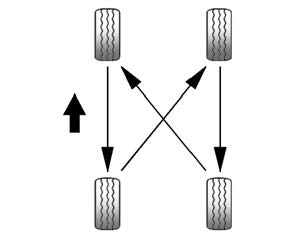
Use this rotation pattern when rotating the tires.
Do not include the compact spare tire in the tire rotation.
Adjust the front and rear tires to the recommended inflation pressure on the Tire and Loading Information label after the tires have been rotated. See Tire Pressure page 292 and Vehicle Load Limits page 190.
Reset the Tire Pressure Monitor System. See Tire Pressure Monitor Operation page 293.
Check that all wheel nuts are properly tightened. See “Wheel Nut Torque” under Capacities and Specifications page 333, and “Removing the Flat Tire and Installing the Spare Tire” under Tire Changing page 304.
Warning
Rust or dirt on a wheel, or on the parts to which it is fastened, can cause wheel nuts to become loose over time. The wheel could come off and cause a crash. When changing a wheel, remove any rust or dirt from places where the wheel attaches to the vehicle. In an emergency, a cloth or paper towel can be used; however, use a scraper or wire brush later to remove all rust or dirt.
Lightly coat the inner diameter of the wheel hub opening with wheel bearing grease after a wheel change or tire rotation to prevent corrosion or rust buildup.
Warning
Do not apply grease to the wheel mounting surface, wheel conical seats, or the wheel nuts or bolts. Grease applied to these areas could cause a wheel to become loose or come off, resulting in a crash.
When It Is Time for New Tires
Factors, such as maintenance, temperatures, driving speeds, vehicle loading, and road conditions affect the wear rate of the tires.
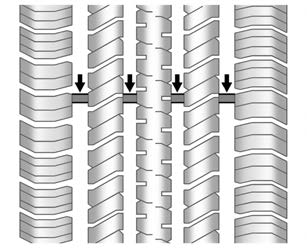
Treadwear indicators are one way to tell when it is time for new tires. Treadwear indicators appear when the tires have only 1.6 mm (1/16 in) or less of tread remaining. See Tire Inspection page 297. an Tire Rotation page 297.
The rubber in tires ages over time. This also applies to the spare tire, if the vehicle has one, even if it is never used. Multiple factors including temperatures, loading conditions, and inflation pressure maintenance affect how fast aging takes place. GM recommends that tires, including the spare if equipped, be replaced after six years, regardless of tread wear. To identify the age of a tire, use the tire manufacture date, which is the last four digits of the DOT Tire Identification Number (TIN) molded into one side of the tire sidewall. The last four digits of the TIN indicate the tire manufactured date. The first two digits represent the week and the last two digits, the year. For example, the third week of the year 2020 would have a digit DOT date of 0320. Week 01 is the first full week (Sunday through Saturday) of each year.
Vehicle Storage
Tires age when stored normally mounted on a parked vehicle. Park a vehicle that will be stored for at least a month in a cool, dry, clean area away from direct sunlight to slow aging. This area should be free of grease, gasoline, or other substances that can deteriorate rubber.
Parking for an extended period can cause flat spots on the tires that may result in vibrations while driving. When storing a vehicle for at least a month, remove the tires or raise the vehicle to reduce the weight from the tires.
Buying New Tires
GM has developed and matched specific tires for the vehicle. The original equipment tires installed were designed to meet General Motors Tire Performance Criteria Specification (TPC Spec) system rating. When replacement tires are needed, GM strongly recommends buying tires with the same TPC Spec rating.
GM’s exclusive TPC Spec system considers over a dozen critical specifications that impact the overall performance of the vehicle, including brake system performance, ride and handling, traction control, and tire pressure monitoring performance. GM’s
TPC Spec number is molded onto the tire’s sidewall near the tire size. If the tires have an all-season tread design, the TPC Spec number will be followed by MS for mud and snow. See Tire Sidewall Labeling page 288 for additional information.
GM recommends replacing worn tires in complete sets of four. Uniform tread depth on all tires will help to maintain the performance of the vehicle. Braking and handling performance may be adversely affected if all the tires are not replaced at the same time. If proper rotation and maintenance have been done, all four tires should wear out at about the same time. However, if it is necessary to replace only one axle set of worn tires, place the new tires on the rear axle. See Tire Rotation page 297.
Warning
Tires could explode during improper service. Attempting to mount or dismount a tire could cause injury or death. Only your dealer or authorized tire service center should mount or dismount the tires.
Warning
Mixing tires of different sizes (other than those originally installed on the vehicle), brands, tread patterns, or types may cause loss of vehicle control, resulting in a crash or other vehicle damage. Use the correct size, brand, and type of tire on all wheels.
Warning
Using bias-ply tires on the vehicle may cause the wheel rim flanges to develop cracks after many miles of driving. A tire and/or wheel could fail suddenly and cause a crash. Use only radial-ply tires with the wheels on the vehicle.
Winter tires with the same speed rating as the original equipment tires may not be available for H, V, W, Y and ZR speed rated tires. Never exceed the winter tires’ maximum speed capability when using winter tires with a lower speed rating.
If the vehicle tires must be replaced with a tire that does not have a TPC Spec number, make sure they are the same size, load range, speed rating, and construction (radial) as the original tires.
The Tire and Loading Information label indicates the original equipment tires on the vehicle. See Vehicle Load Limits .
Different Size Tires and Wheels
If wheels or tires are installed that are a different size than the original equipment wheels and tires, vehicle performance, including its braking, ride and handling characteristics, stability, and resistance to rollover may be affected. If the vehicle has electronic systems such as antilock brakes, rollover airbags, traction control, electronic stability control, or All-Wheel Drive, the performance of these systems can also be affected .
Warning
If different sized wheels are used, there may not be an acceptable level of performance and safety if tires not recommended for those wheels are selected. This increases the chance of a crash and serious injury. Only use GM specific wheel and tire systems developed for the vehicle, and have them properly installed by a GM certified technician.
See Buying New Tires page 299 and Accessories and Modifications page 250.
Uniform Tire Quality Grading
The following information relates to the system developed by the United States National Highway Traffic Safety Administration (NHTSA), which grades tires by treadwear, traction, and temperature performance. This applies only to vehicles sold in the United States. The grades are molded on the sidewalls of most passenger car tires.
The Uniform Tire Quality Grading (UTQG) system does not apply to deep tread, winter tires, compact spare tires, tires with nominal rim diameters of 10 to 12 inches (25 to 30 cm), or to some limited-production tires.
While the tires available on General Motors passenger cars and light trucks may vary with respect to these grades, they must also conform to federal safety requirements and additional General Motors Tire Performance Criteria (TPC) standards.
Quality grades can be found where applicable on the tire sidewall between tread shoulder and maximum section width. For example:
Treadwear 200 Traction AA Temperature A
All Passenger Car Tires Must Conform to Federal Safety Requirements In Addition To These Grades.
Treadwear
The treadwear grade is a comparative rating based on the wear rate of the tire when tested under controlled conditions on a specified government test course. For example, a tire graded 150 would wear one and one-half (1½) times as well on the government course as a tire graded 100. The relative performance of tires depends upon the actual conditions of their use, however, and may depart significantly from the norm due to variations in driving habits, service practices and differences in road characteristics and climate.
Traction
The traction grades, from highest to lowest, are AA, A, B, and C. Those grades represent the tire’s ability to stop on wet pavement as measured under controlled conditions on specified government test surfaces of asphalt and concrete. A tire marked C may have poor traction performance. Warning: The traction grade assigned to this tire is based on straight-ahead braking traction tests, and does not include acceleration, cornering, hydroplaning, or peak traction characteristics.
Temperature
The temperature grades are A (the highest), B, and C, representing the tire’s resistance to the generation of heat and its ability to dissipate heat when tested under controlled conditions on a specified indoor laboratory test wheel. Sustained high temperature can cause the material of the tire to degenerate and reduce tire life, and excessive temperature can lead to sudden tire failure. The grade C corresponds to a level of performance which all passenger car tires must meet under the Federal Motor Safety Standard No. 109. Grades B and A represent higher levels of performance on the laboratory test wheel than the minimum required by law. Warning: The temperature grade for this tire is established for a tire that is properly inflated and not overloaded. Excessive speed, underinflation, or excessive loading, either separately or in combination, can cause heat buildup and possible tire failure.
Wheel Alignment and Tire Balance
The tires and wheels were aligned and balanced at the factory to provide the longest tire life and best overall performance. Adjustments to wheel alignment and tire balancing are not necessary on a regular basis. Consider an alignment check if there is unusual tire wear or the vehicle is significantly pulling to one side or the other. Some slight pull to the left or right, depending on the crown of the road and/or other road surface variations such as troughs or ruts, is normal. If the vehicle is vibrating when driving on a smooth road, the tires and wheels may need to be rebalanced. See your dealer for proper diagnosis.
Wheel Replacement
Replace any wheel that is bent, cracked, or badly rusted or corroded. If wheel nuts keep coming loose, the wheel, wheel bolts, and wheel nuts should be replaced. If the wheel leaks air, replace it. Some aluminum wheels can be repaired. See your dealer if any of these conditions exist.
Wheel Alignment and Tire Balance
The tires and wheels were aligned and balanced at the factory to provide the longest tire life and best overall performance. Adjustments to wheel alignment and tire balancing are not necessary on a regular basis. Consider an alignment check if there is unusual tire wear or the vehicle is significantly pulling to one side or the other. Some slight pull to the left or right, depending on the crown of the road and/or other road surface variations such as troughs or ruts, is normal. If the vehicle is vibrating when driving on a smooth road, the tires and wheels may need to be rebalanced. See your dealer for proper diagnosis.
Wheel Replacement
Replace any wheel that is bent, cracked, or badly rusted or corroded. If wheel nuts keep coming loose, the wheel, wheel bolts, and wheel nuts should be replaced. If the wheel leaks air, replace it. Some aluminum wheels can be repaired. See your dealer if any of these conditions exist Your dealer will know the kind of wheel that is needed.
Each new wheel should have the same load-carrying capacity, diameter, width, offset, and be mounted the same way as the one it replaces.
Replace wheels, wheel bolts, wheel nuts, or Tire Pressure Monitor System (TPMS) sensors with new GM original equipment parts .
Warning
Using the wrong replacement wheels, wheel bolts, or wheel nuts can be dangerous. It could affect the braking and handling of the vehicle. Tires can lose air and cause loss of control, resulting in a crash. Always use the correct wheel, wheel bolts, and wheel nuts for replacement.
Replacing a wheel with a used one is dangerous. How it has been used or how far it has been driven may be unknown.
It could fail suddenly and cause a crash. When replacing wheels, use a new GM original equipment wheel.
Caution
The wrong wheel can also cause problems with bearing life, brake cooling, speedometer or odometer calibration, headlamp aim, bumper height, vehicle ground clearance, and tire or tire chain clearance to the body and chassis.
Tire Chains
Warning
If the vehicle has a tire size other than 255/65R18, do not use tire chains. There is not enough clearance. Tire chains used on a vehicle without the proper amount of clearance can cause damage to the brakes, suspension, or other vehicle parts. The area damaged by the tire chains could cause loss of control and a crash. Use another type of traction device only if its manufacturer recommends it for the vehicle’s tire size combination and road conditions. Follow that manufacturer’s instructions. To avoid vehicle damage, drive slow and readjust or remove the traction device if it contacts the vehicle. Do not spin the wheels. If traction devices are used, install them on the front tires.
Caution
If the vehicle is equipped with 255/65R18 size tires, use tire chains only where legal and only when necessary. Use low profile chains that add no more than 12 mm thickness to the tire tread and inner sidewall. Use chains that are the proper size for the tires. Install them on the tires of the front axle. Do not use chains on the tires of the rear axle. Tighten them as tightly as possible with the ends securely fastened. Drive slowly and follow the chain manufacturer’s instructions.
If the chains contact the vehicle, stop and retighten them. If the contact continues, slow down until it stops. Driving too fast or spinning the wheels with chains on will damage the vehicle.
If a Tire Goes Flat
It is unusual for a tire to blow out while driving, especially if the tires are maintained properly. See Tires page 285. If air goes out of a tire, it is much more likely to leak out slowly. But if there is ever a blowout, here are a few tips about what to expect and what to do:
If a front tire fails, the flat tire creates a drag that pulls the vehicle toward that side. Take your foot off the accelerator pedal and grip the steering wheel firmly. Steer to maintain lane position, and then gently brake to a stop, well off the road, if possible.
A rear blowout, particularly on a curve, acts much like a skid and may require the same correction as used in a skid. Stop pressing the accelerator pedal and steer to straighten the vehicle. It may be very bumpy and noisy. Gently brake to a stop, well off the road, if possible.
Warning
Driving on a flat tire will cause permanent damage to the tire.
Re-inflating a tire after it has been driven on while severely underinflated or flat may cause a blowout and a serious crash. Never attempt to re-inflate a tire that has been driven on while severely underinflated or flat. Have your dealer or an authorized tire service center repair or replace the flat tire as soon as possible.
Warning
Lifting a vehicle and getting under it to do maintenance or repairs is dangerous without the appropriate safety equipment and training. If a jack is provided with the vehicle, it is designed only for changing a flat tire. If it is used for anything else, you or others could be badly injured or killed if the vehicle slips off the jack. If a jack is provided with the vehicle, only use it for changing a flat tire.
If a tire goes flat, avoid further tire and wheel damage by driving slowly to a level place, well off the road, if possible. Turn on the hazard warning flashers.
If your vehicle is loaded at or near maximum cargo capacity, it may be difficult to fit the jack under the vehicle due to the environment (shoulder slope, road debris, etc.). Removal of some weight may improve the ability to fit the jack under the vehicle at the correct jacking location.
Warning
Changing a tire can be dangerous. The vehicle can slip off the jack and roll over or fall causing injury or death. Find a level place to change the tire. To help prevent the vehicle from moving:
- Set the parking brake firmly.
‘Put the vehicle in P (Park). - Turn the vehicle off and do not restart the vehicle while it is raised.
- Do not allow passengers to remain in the vehicle.
- Place wheel blocks, if equipped, on both sides of the tire at the opposite corner of the tire being changed.
When the vehicle has a flat tire (2), use the following example as a guide to assist in the placement of the wheel blocks (1), if equipped.

- Wheel Block (If Equipped)
- Flat Tire
The following information explains how to repair or change a tire.
Tire Changing
Removing the Spare Tire and Tools
To access the spare tire and tools:
- Open the liftgate.
- Lift the load floor.
- Remove the cargo management system.
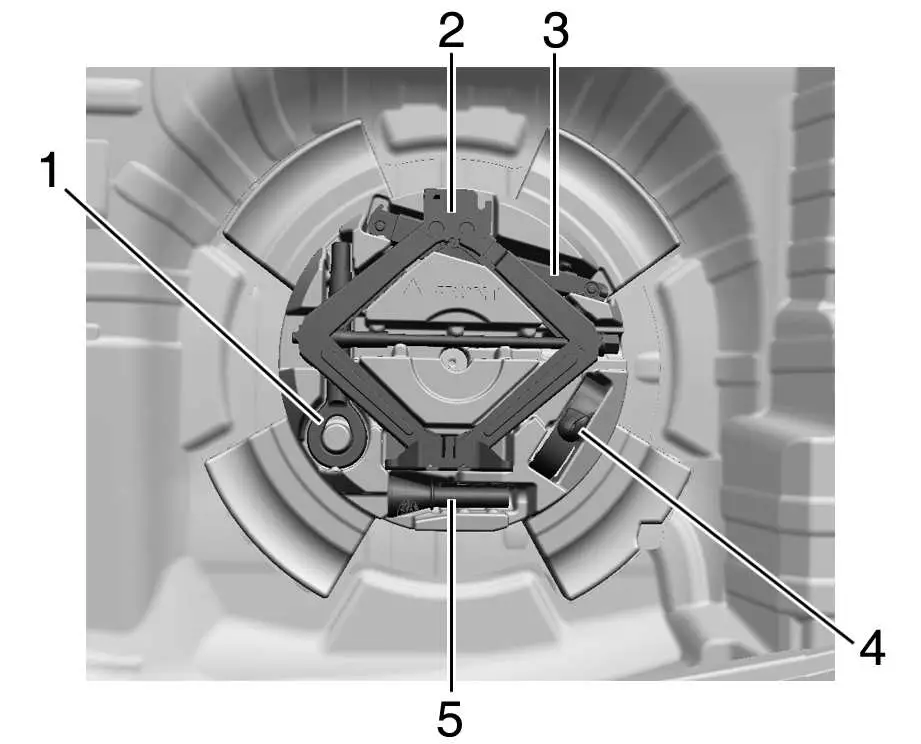
Without Subwoofer
- Tow Eye
- Jack
- Wrench
- Strap
- Funnel

With Subwoofer
- Tow Eye
- Wrench
- Jack
- Strap
- Wing Nut
- Funnel
To access the spare tire and tools:
- Open the liftgate. See Liftgate page 19.
- Remove the load floor.
- Turn the wing nut counterclockwise and remove the spare tire. Place the spare tire next to the tire being changed.
- Remove the jack and tools and place them near the tire being changed.
Removing the Flat Tire and Installing the Spare Tire
- Do a safety check before proceeding. See If a Tire Goes Flat page 33.
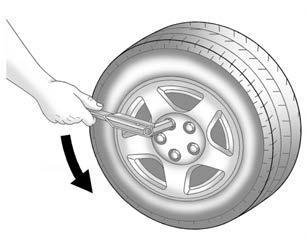
- Turn the wheel wrench counterclockwise to loosen all the wheel nuts, but do not remove them yet.

- Place the jack at the position marked with a half circle.
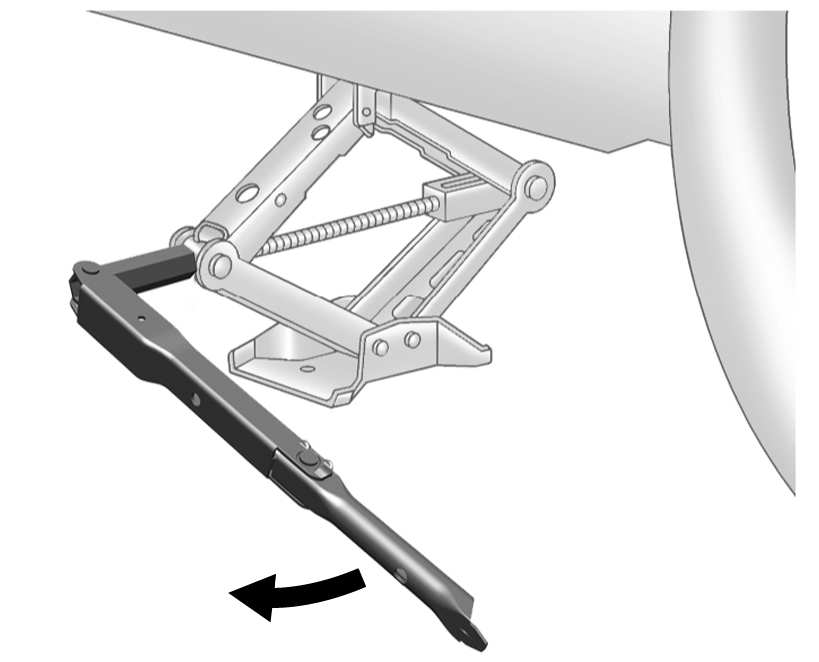
- Place the hex tube end of the wrench over the hex head of the jack to attach it.
- Turn the wheel wrench clockwise until the lift head is firmly contacting the proper lifting point nearest the flat tire.
Warning
Getting under a vehicle when it is lifted on a jack is dangerous. If the vehicle slips off the jack, you could be badly injured or killed. Never get under a vehicle when it is supported only by a jack.
Raising the vehicle with the jack improperly positioned can damage the vehicle and even make the vehicle fall. To help avoid personal injury and vehicle damage, be sure to fit the jack lift head into the proper location before raising the vehicle.
Lifting a vehicle and getting under it to do maintenance or repairs is dangerous without the appropriate safety equipment and training. If a jack is provided with the vehicle, it is designed only for changing a flat tire. If it is used for anything else, you or others could be badly injured or killed if the vehicle slips off the jack. If a jack is provided with the vehicle, only use it for changing a flat tire. - Turn the wheel wrench clockwise to raise the vehicle far enough off the ground so there is enough room for the spare tire to fit underneath the wheel well.
- Turn the wheel nuts counterclockwise to remove them.
- Remove the flat tire.
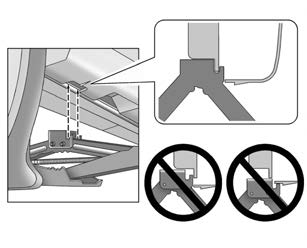
- Turn the wheel wrench clockwise to raise the jack lift head until the slots in the jack head fit into the metal flange behind the cut out on the plastic molding. Do not raise the vehicle yet.
- Put the compact spare tire near you.
- Turn the wrench clockwise in the jack to raise the vehicle. Raise the vehicle far enough off the ground so that there is enough room for the spare tire to fit under the wheel well
Warning
Rust or dirt on a wheel, or on the parts to which it is fastened, can cause wheel nuts to become loose over time. The wheel could come off and cause a crash. When changing a wheel, remove any rust or dirt from places where the wheel attaches to the vehicle. In an emergency, a cloth or paper towel can be used; however, use a scraper or wire brush later to remove all rust or dirt. - Remove any rust or dirt from the wheel bolts, mounting surfaces, and spare wheel.
- Place the spare tire on the wheel-mounting surface.
- Remove all of the wheel nuts.
- Remove the flat tire.
Warning
Rust or dirt on a wheel, or on the parts to which it is fastened, can cause wheel nuts to become loose over time. The wheel could come off and cause a crash. When changing a wheel, remove any rust or dirt from places where the wheel attaches to the vehicle. In an emergency, a cloth or paper towel can be used; however, use a scraper or wire brush later to remove all rust or dirt.
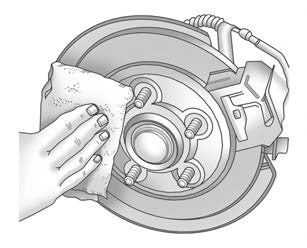 Warning
Warning
Never use oil or grease on bolts or nuts because the nuts might come loose. The vehicle’s wheel could fall off, causing a crash. - Reinstall the wheel nuts. Tighten each nut by hand until the wheel is held against the hub.
- Lower the vehicle by turning the jack handle counterclockwise.
Warning
Wheel nuts that are improperly or incorrectly tightened can cause the wheels to become loose or come off. The wheel nuts should be tightened with a torque wrench to the proper torque specification after replacing. Follow the torque specification supplied by the aftermarket manufacturer when using accessory locking wheel nuts. See Capacities and Specifications 0 for original equipment wheel nut torque specifications.
Caution
Improperly tightened wheel nuts can lead to brake pulsation and rotor damage. To avoid expensive brake repairs, evenly tighten the wheel nuts in the proper sequence and to the proper torque specification. See Capacities and Specifications page 332 for the wheel nut torque specification.
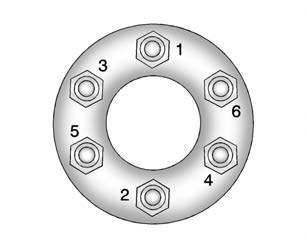
- Tighten the wheel nuts firmly with the wheel wrench in a crisscross sequence, as shown.
Caution
Wheel covers will not fit on the vehicle’s compact spare. If you try to put a wheel cover on the compact spare, the cover or the spare could be damaged.
Storing a Flat or Spare Tire and Tools
Warning
Storing a jack, a tire, or other equipment in the passenger compartment of the vehicle could cause injury. In a sudden stop or collision, loose equipment could strike someone. Store all these in the proper place.
Storing the Flat Tire and Tools
- Return the jack and tools to their original storage location.
- Replace the load floor.
- Place the flat tire, lying flat, in the rear storage compartment.
- Attach one end of the strap to a cargo tie-down in the rear of the vehicle.
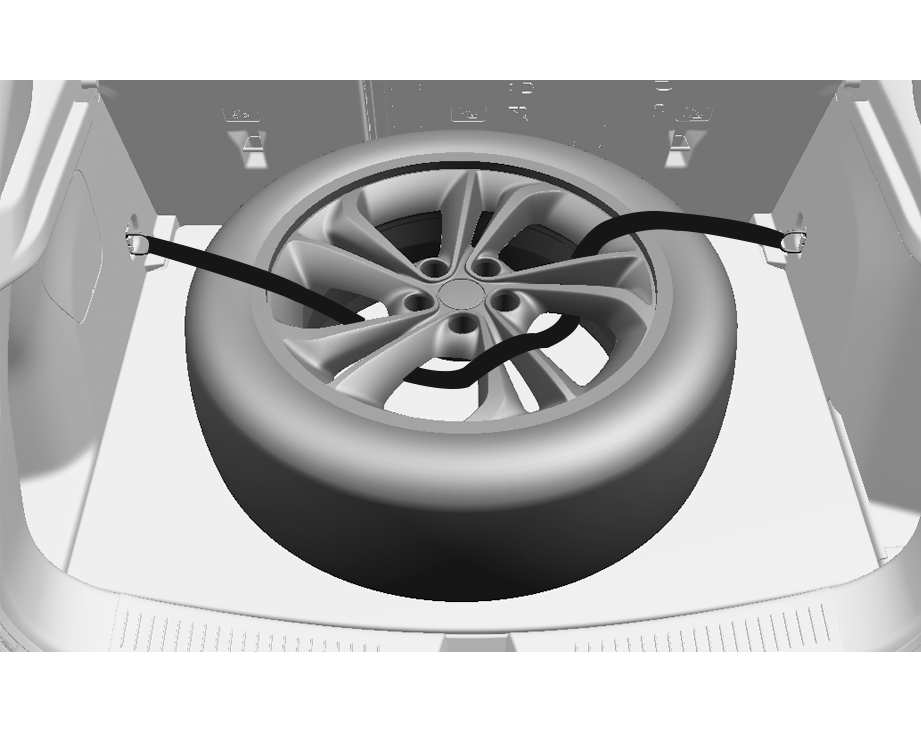
- Route the strap through the wheel, as shown.
- Attach the other end of the strap to the other cargo tie-down in the rear of the vehicle.
- Tighten the strap.
- Storing the Compact Spare Tire and Tools
To store the spare tire and tools:
Reverse the instructions for removing the spare tire and tools to store the spare tire.
Reverse the instructions for removing the spare tire and tools to store the spare tire.
The compact spare tire is for temporary use only. Replace the compact spare tire with a full-size tire as soon as you can. See Compact Spare Tire page 308.
The compact spare is for temporary use only. Replace the compact spare tire with a full-size tire as soon as you can.
Compact Spare Tire
Warning
Driving with more than one compact spare tire at a time could result in loss of braking and handling. This could lead to a crash and you or others could be injured. Use only one compact spare tire at a time.
If this vehicle has a compact spare tire, it was fully inflated when new; however, it can lose air over time. Check the inflation pressure regularly. It should be 420 kPa (60 psi).
Stop as soon as possible and check that the spare tire is correctly inflated after being installed on the vehicle. The compact spare tire is designed for temporary use only. The vehicle will perform differently with the spare tire installed and it is recommended that the vehicle speed be limited to 80 km/h (50 mph). To conserve the tread of the spare tire, have the standard tire repaired or replaced as soon as convenient and return the spare tire to the storage area.
When using a compact spare tire, the AWD (if equipped), ABS, and Traction Control systems may engage until the spare tire is recognized by the vehicle, especially on slippery roads. Adjust driving to reduce possible wheel slip.
Caution
When the compact spare is installed, do not take the vehicle through an automatic car wash with guide rails. The compact spare can get caught on the rails which can damage the tire, wheel, and other parts of the vehicle.
Do not use the compact spare on other vehicles.
Do not mix the compact spare tire or wheel with other wheels or tires. They will not fit. Keep the spare tire and its wheel together.
Caution
Tire chains will not fit the compact spare. Using them can damage the vehicle and the chains. Do not use tire chains on the compact spare.
Jump Starting
Jump Starting – North America
For more information about the vehicle battery, see Battery – North America page 268.
If the battery has run down, try to use another vehicle and some jumper cables to start your vehicle. Be sure to use the following steps to do it safely.
Warning
WARNING: Battery posts, terminals and related accessories can expose you to chemicals including lead and lead compounds, which are known to the State of California to cause cancer and birth defects or other reproductive harm. Wash hands after handling. For more information go to www.P65Warnings.ca.gov
See California Proposition 65 Warning page 1.
Warning
Batteries can hurt you. They can be dangerous because
- They contain acid that can burn you.
- They contain gas that can explode or ignite.
- They contain enough electricity to burn you.
If you do not follow these steps exactly, some or all of these things can hurt you.
Caution
Ignoring these steps could result in costly damage to the vehicle that would not be covered by the vehicle warranty. Trying to start the vehicle by pushing or pulling it will not work, and it could damage the vehicle.
Caution
If the jumper cables are connected or removed in the wrong order, electrical shorting may occur and damage the vehicle. The repairs would not be covered by the vehicle warranty. Always connect and remove the jumper cables in the correct order, making sure that the cables do not touch each other or other metal.

Connection Points and Sequence
- Discharged Battery Positive (+) Terminal
- Good Battery Positive (+) Terminal
- Good Battery Negative (−) Terminal
- Discharged Battery Negative (−) Grounding Point
The discharged battery positive (+) terminal and the discharged battery negative (–) grounding point are on the driver side of the vehicle.
The good battery positive (+) terminal and the good battery negative (–) terminal are on the battery of the vehicle providing the jump start.
The discharged battery positive (+) terminal is under a cover. Open the cover to expose the terminal.
- . Check the other vehicle. It must have a 12-volt battery with a negative ground system.
Caution
If the other vehicle does not have a 12-volt system with a negative ground, both vehicles can be damaged. Only use a vehicle that has a 12-volt system with a negative ground for jump starting. - Position the two vehicles so that they are not touching.
- Set the parking brake firmly and put the shift lever in P (Park) with an automatic transmission, or Neutral with a manual transmission.
Caution
If any accessories are left on or plugged in during the jump starting procedure, they could be damaged. The repairs would not be covered by the vehicle warranty. Whenever possible, turn off or unplug all accessories on either vehicle when jump starting. - Turn the ignition off. Turn off all lights and accessories in both vehicles, except the hazard warning flashers if needed
Warning
An electric fan can start up even when the engine is not running and can injure you. Keep hands, clothing, and tools away from any underhood electric fan.
Using a match near a battery can cause battery gas to explode. People have been hurt doing this, and some have been blinded. Use a flashlight if you need more light.
Battery fluid contains acid that can burn you. Do not get it on you. If you accidentally get it in your eyes or on your skin, flush the place with water and get medical help immediately.
Fans or other moving engine parts can injure you badly. Keep your hands away from moving parts once the engine is running. - Connect one end of the red positive (+) cable to the discharged battery positive (+) terminal.
- Connect the other end of the red positive (+) cable to the good battery positive (+) terminal.
- Connect one end of the black negative (–) cable to the good battery negative (–) terminal.
- Connect the other end of the black negative (–) cable to the discharged battery negative (–) grounding point.
- Start the engine in the vehicle with the good battery and run the engine at idle speed for at least four minutes.
- Try to start the vehicle that had the dead battery. If it will not start after a few tries, it probably needs service.
Jumper Cable Removal
Reverse the sequence exactly when removing the jumper cables.
After starting the disabled vehicle and removing the jumper cables, allow it to idle for several minutes.
Towing the Vehicle
Transporting a Disabled Vehicle
Caution
Incorrectly transporting a disabled vehicle may cause damage to the vehicle. Use proper tire straps to secure the vehicle to the flatbed tow truck. Do not strap or hook to any frame, underbody,
or suspension component not specified below. Do not move vehicles with drive axle tires on the ground. Damage is not covered by the vehicle warranty.
The vehicle may be equipped with an electric parking brake and/or an electronic shifter. In the event of a loss of 12-volt battery power, the electric parking brake cannot be released, and the vehicle cannot be shifted to N (Neutral). Tire skates or dollies must be used under the non-rolling tires to prevent damage while loading/unloading the vehicle. Dragging the vehicle will cause damage not covered by the vehicle warranty.
The vehicle may be equipped with an electric parking brake and/or an electronic shifter. In the event of a loss of 12-volt battery power, the electric parking brake cannot be released, and the vehicle cannot be shifted to N (Neutral). Tire skates or dollies must be used under the non-rolling tires to prevent damage while loading/unloading the vehicle. Dragging the vehicle will cause damage not covered by the vehicle warranty.
Contact a professional towing service if the disabled vehicle must be transported. GM recommends a flatbed tow truck to transport a disabled vehicle. Use ramps to help reduce approach angles, if necessary.
If equipped, a tow eye may be located near the spare tire or emergency jack. Do not use the tow eye to pull the vehicle from the snow, mud, sand, or ditch. Tow eye threads may have right or left-hand threads. Use caution when installing or removing the tow eye.
The vehicle must be in N (Neutral) and the electric parking brake must be released when loading the vehicle onto a flatbed tow truck.
- If the vehicle is equipped with car wash mode and has 12-volt battery power, refer to “Car Wash Mode” under Automatic Transmission page 207 to place the vehicle in N (Neutral).
- If the 12-volt battery is dead and/or the engine will not start, the vehicle will not move. Try to jump start the Refer to Jump Starting – North America page 309 and if the jump start is successful, retry the “Car Wash Mode” procedure.
- If jump starting is unsuccessful, the vehicle will not move. Tire skates or dollies must be used under the non-rolling tires to prevent vehicle damage.
Front Attachment Points
 The vehicle is equipped with specific attachment points to be used by the towing provider. These holes may be used to pull the vehicle from a flat road surface onto the flatbed tow truck.
The vehicle is equipped with specific attachment points to be used by the towing provider. These holes may be used to pull the vehicle from a flat road surface onto the flatbed tow truck.
Recreational Vehicle Towing
Recreational vehicle towing means towing the vehicle behind another vehicle, such as behind a motor home. The two most common types of recreational vehicle towing are known as dinghy towing and dolly towing. Dinghy towing is towing the vehicle with all four wheels on the ground.
Dolly towing is towing the vehicle with two wheels on the ground and two wheels up on a device known as a dolly.
Here are some important things to consider before recreational vehicle towing:
- Before towing the vehicle, become familiar with the local laws that apply to recreational vehicle towing. These laws may vary by region.
- The towing capacity of the towing vehicle. Be sure to read the tow vehicle manufacturer’s recommendations.
- How far the vehicle will be towed. Some vehicles have restrictions on how far and how long they can be towed.
- The proper towing equipment. See your dealer or trailering professional for additional advice and equipment recommendations.
- If the vehicle is ready to be towed. Just as preparing the vehicle for a long trip, make sure the vehicle is prepared to be towed.
Caution
Use of a shield mounted in front of the vehicle grille could restrict airflow and cause damage to the transmission. The repairs would not be covered by the vehicle warranty. If using a shield, only use one that attaches to the towing vehicle.
Dinghy Towing (Front-Wheel-Drive Vehicles)
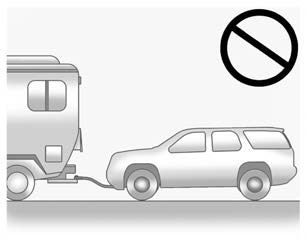
Caution
If the vehicle is towed with all four wheels on the ground, the drivetrain components could be damaged. The repairs would not be covered by the vehicle warranty. Do not tow the vehicle with all four wheels on the ground.
The vehicle is not designed to be towed with all four wheels on the ground. If the vehicle must be towed, a dolly should be used. See the following information on dolly towing.
Dinghy Towing (All-Wheel-Drive Vehicles Only)

Driving onto a Dolly
- Park the vehicle on level ground in front of the dolly and turn the vehicle off.
- Make sure the parking brake is released .
- Press and hold ENGINE START/STOP with your foot off the brake for five seconds.
- Hold the brake pedal down and press the parking brake switch for 15 seconds until the service parking brake light flashes.
- While the service parking brake light is still flashing, remove your foot from the brake pedal and release the parking brake switch.
- Immediately press and release the parking brake switch again while the service park brake light is still flashing.
- Start the vehicle and drive onto the dolly.
- Place the vehicle in P (Park).
- Turn off the vehicle .
- Open the hood.
- Exit the vehicle and secure the vehicle onto the dolly.
- Disconnect the negative (–) terminal connector from the 12-volt battery.
- Close the hood of the vehicle .
Removing the Vehicle from a Dolly
- Make sure the vehicle is secured to the
- Open the door and hood of the vehicle .
- Connect the negative (–) terminal connector from the 12-volt
- Press and hold ENGINE START/STOP with your foot off the brake for five seconds.
- Hold the brake pedal down and press the parking brake switch for five seconds until the parking brake light flashes.
- Turn the vehicle off.
- Disconnect the vehicle and remove it from the dolly.
Towing the Vehicle from the Rear


Caution
Towing the vehicle from the rear could damage it. Also, repairs would not be covered by the vehicle warranty. Never have the vehicle towed from the rear.
Do not tow the vehicle from the rear.
Appearance Care
Exterior Care
Locks
Locks are lubricated at the factory. Use a deicing agent only when absolutely necessary, and have the locks greased after using. See Recommended Fluids and Lubricants page 328.
Washing the Vehicle
To preserve the vehicle’s finish, wash it often and out of direct sunlight.
Caution
Avoid using high-pressure washes closer than 30 cm (12 in) to the surface of the vehicle. Use of power washers exceeding 8 274 kPa (1,200 psi) can result in damage or removal of paint and decals.
Caution
Do not power wash any component under the hood that has this e symbol.
This could cause damage that would not be covered by the vehicle warranty.
If using an automatic car wash, follow the car wash instructions. The windshield wiper and rear window wiper, if equipped, must be off. Remove any accessories that may be damaged or interfere with the car wash equipment.
Rinse the vehicle well, before washing and after, to remove all cleaning agents completely. If they are allowed to dry on the surface, they could stain.
Dry the finish with a soft, clean chamois or an all-cotton towel to avoid surface scratches and water spotting.
Finish Care
Application of aftermarket clearcoat sealant/ wax materials is not recommended.
If painted surfaces are damaged, see your dealer to have the damage assessed and repaired. Foreign materials such as calcium chloride and other salts, ice melting agents, road oil and tar, tree sap, bird droppings, chemicals from industrial chimneys, etc., can damage the vehicle’s finish if they remain on painted surfaces. Wash the vehicle as soon as possible. If necessary, use non-abrasive cleaners that are marked safe for painted surfaces to remove foreign matter.
Occasional hand waxing or mild polishing should be done to remove residue from the paint finish. See your dealer for approved cleaning products.
Do not apply waxes or polishes to uncoated plastic, vinyl, rubber, decals, simulated wood, or flat paint as damage can occur.
Caution
Machine compounding or aggressive polishing on a basecoat/clearcoat paint finish may damage it. Use only
non-abrasive waxes and polishes that are made for a basecoat/clearcoat paint finish on the vehicle.
To keep the paint finish looking new, keep the vehicle garaged or covered whenever possible.
Protecting Exterior Bright Metal Moldings
Caution
Failure to clean and protect the bright metal moldings can result in a hazy white finish or pitting. This damage would not be covered by the vehicle warranty.
The bright metal moldings on the vehicle are aluminum, chrome, or stainless steel. To prevent damage always follow these cleaning instructions:
- Be sure the molding is cool to the touch before applying any cleaning solution.
- Use only approved cleaning solutions for aluminum, chrome, or stainless steel.
- Some cleaners are highly acidic or contain alkaline substances and can damage the moldings.
- Always dilute a concentrated cleaner according to the manufacturer’s
- Do not use cleaners that are not intended for automotive use.
- Use a nonabrasive wax on the vehicle after washing to protect and extend the molding finish.
- Cleaning Exterior Lamps/Lenses, Emblems, Decals, and Stripes
Use only lukewarm or cold water, a soft cloth, and a car washing soap to clean exterior lamps, lenses, emblems, decals, and stripes. Follow instructions under “Washing the Vehicle” previously in this section. Lamp covers are made of plastic, and some have a UV protective coating. Do not clean or wipe them when dry.Do not use any of the following on lamp covers:- Abrasive or caustic agents
- Washer fluids and other cleaning agents in higher concentrations than suggested by the manufacturer
- Solvents, alcohols, fuels, or other harsh cleaners
- Ice scrapers or other hard items
- Aftermarket appearance caps or covers while the lamps are illuminated, due to excessive heat generated.
- Caution
Failure to clean lamps properly can cause damage to the lamp cover that would not be covered by the vehicle warranty. - Caution
Using wax on low gloss black finish stripes can increase the gloss level and create a non-uniform finish. Clean low gloss stripes with soap and water only.
Air Intakes
Clear debris from the air intakes, between the hood and windshield, when washing the vehicle.
Shutter System
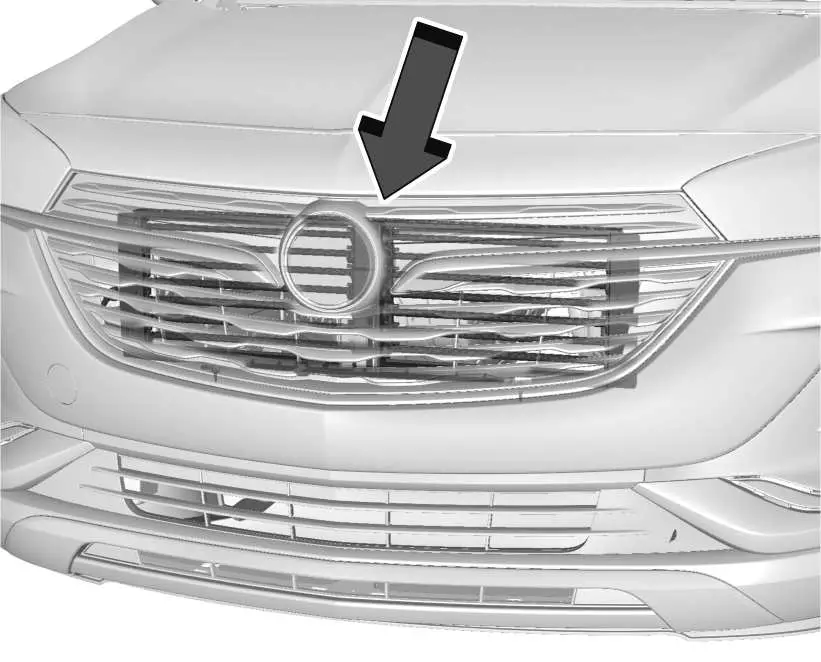
The vehicle may have a shutter system designed to help improve fuel economy. Keep the shutter system clear of debris, snow and ice. If the check engine light is activated, please check to see if the shutter system is clear of debris, snow or ice.
Windshield and Wiper Blades
Clean the outside of the windshield with glass cleaner.
Clean rubber blades using a lint-free cloth or paper towel soaked with windshield washer fluid or a mild detergent. Wash the windshield thoroughly when cleaning the blades. Bugs, road grime, sap, and a buildup of vehicle wash/wax treatments may cause wiper streaking.
Replace the wiper blades if they are worn or damaged. Damage can be caused by extreme dusty conditions, sand, salt, heat, sun, snow, and ice.
Weatherstrips
Apply weatherstrip lubricant on weatherstrips to make them last longer, seal better, and not stick or squeak. Lubricate weatherstrips at least once a year. Hot, dry climates may require more frequent application. Black marks from rubber material on painted surfaces can be removed by rubbing with a clean cloth. See Recommended Fluids and Lubricants page 328.
Tires
Use a stiff brush with tire cleaner to clean the tires.
Caution
Using petroleum-based tire dressing products on the vehicle may damage the paint finish and/or tires. When applying a tire dressing, always wipe off any overspray from all painted surfaces on the vehicle.
Wheels and Wheel Trim
Use a soft, clean cloth with mild soap and water to clean the wheels. After rinsing thoroughly with clean water, dry with a soft, clean towel. A wax may then be applied.
Caution
Chrome wheels and chrome wheel trim may be damaged if the vehicle is not washed after driving on roads that have been sprayed with magnesium chloride or calcium chloride. These are used on roads for conditions such as dust and ice. Always wash the chrome with soap and water after exposure.
Caution
To avoid surface damage on wheels and wheel trim, do not use strong soaps, chemicals, abrasive polishes, cleaners, or brushes. Use only GM approved cleaners. Do not drive the vehicle through an automatic car wash that uses silicon carbide tire/wheel cleaning brushes. Damage could occur and the repairs would not be covered by the vehicle warranty.
Brake System
Visually inspect brake lines and hoses for proper attachment, connections, binding, leaks, cracks, chafing, etc. Inspect disc brake pads for wear and rotors for surface condition. Inspect drum brake linings/shoes for wear or cracks. Inspect all other brake parts for cracks and leaks.
Steering, Suspension, and Chassis Components
Visually inspect steering, suspension, and chassis components for damaged, loose, or missing parts or signs of wear at least once a year.
Inspect power steering for proper electrical connections, binding, cracks, chafing, etc.
Visually check constant velocity joint boots and axle seals for leaks.
Body Component Lubrication
Lubricate all key lock cylinders, hood hinges, liftgate hinges, and the steel fuel door hinges, unless the components are plastic. Applying silicone grease on weatherstrips with a clean cloth will make them last longer, seal better, and not stick or squeak.
Underbody Maintenance
At least twice a year, spring and fall, use plain water to flush any corrosive materials from the underbody. Take care to thoroughly clean any areas where mud and other debris can collect.
Do not directly power wash the transfer case and/or front/rear axle output seals. High pressure water can overcome the seals and contaminate the fluid. Contaminated fluid will decrease the life of the transfer case and/or axles and should be replaced.
Sheet Metal Damage
If the vehicle is damaged and requires sheet metal repair or replacement, make sure the body repair shop applies anti-corrosion material to parts repaired or replaced to restore corrosion protection.
Original manufacturer replacement parts will provide the corrosion protection while maintaining the vehicle warranty.
Finish Damage
Quickly repair minor chips and scratches with touch-up materials available from your dealer to avoid corrosion. Larger areas of finish damage can be corrected in your dealer’s body and paint shop.
Chemical Paint Spotting
Airborne pollutants can fall upon and attack painted vehicle surfaces causing blotchy, ring-shaped discolorations, and small, irregular dark spots etched into the paint surface. See “Finish Care” previously in this section.
Interior Care
To prevent dirt particle abrasions, regularly clean the vehicle’s interior. Before using cleaners, read and follow all safety instructions on the label. While cleaning the interior, open the doors and windows to get proper ventilation. Newspapers or dark garments can transfer color to the vehicle’s interior.
Caution
Immediately remove cleaners, hand lotions, sunscreen, and insect repellent from all interior surfaces or permanent damage may result.
Caution
Use cleaners specifically designed for the surfaces being cleaned to prevent permanent damage to the vehicle. Apply all cleaners directly to a cleaning cloth. Do not spray cleaners on any switches or controls.
When using liquid soap cleaners, follow the directions on the specific cleaner or soap solution for dilution instructions.
To prevent damage:
- Never use a razor or any other sharp object to remove soil from any interior surface
- Never use a brush with stiff
- Never rub any surface aggressively or with too much pressure.
- Do not get any exposed electrical components wet.
- Do not use laundry detergents or dishwashing soaps with degreasers. Do not use solutions that contain strong or caustic soap.
- Do not heavily saturate the upholstery when cleaning.
- Do not use solvents or cleaners containing solvents.
- Do not use disinfecting wipes that are scented or contain Do not use wipes or cleaners that show a color transfer to the wipe or change the appearance of the interior surface when used.
- Do not use scented or gel-type hand sanitizers. If hand sanitizer comes in contact with interior surfaces of the vehicle, blot immediately and clean with a soft cloth dampened with a mild soap and water solution.
Interior Glass
To clean, use a microfiber cloth fabric dampened with water. Wipe droplets left behind with a clean dry cloth. If necessary, use a commercial glass cleaner after cleaning with plain water.
Caution
To prevent scratching, never use abrasive cleaners on automotive glass. Abrasive cleaners or aggressive cleaning may damage the rear window defogger.
Cleaning the windshield with water during the first three to six months of ownership will reduce tendency to fog.
Speaker Covers
Vacuum around a speaker cover gently, so that the speaker will not be damaged. Clean spots with water and mild soap.
Coated Moldings
Coated moldings should be cleaned.
- When lightly soiled, wipe with a sponge or soft, lint-free cloth dampened with water .
- When heavily soiled, use warm soapy water.
Vinyl/Rubber
If equipped with vinyl floor and rubber floor mats, use a soft cloth and/or brush dampened with water to remove dust and loose dirt. For more thorough cleaning, use a mild soap and water solution.
Warning
Do not use cleaners that contain silicone, wax-based products, or cleaners that increase gloss on vinyl/rubber floor and mats. These cleaners can permanently change the appearance and feel of the vinyl/rubber and can make the floor slippery. Your foot could slip while operating the vehicle, and you could lose control, resulting in a crash. You or others could be injured.
Fabric/Carpet/Suede
Start by vacuuming the surface using a soft brush attachment. If a rotating vacuum brush attachment is being used, only use it on the floor carpet. Before cleaning, gently remove as much of the soil as possible:
Gently blot liquids with a paper towel. Continue blotting until no more soil can be removed.
- For solid soils, remove as much as possible prior to vacuuming.
To clean:
- Saturate a clean, lint-free colorfast cloth with water. Microfiber cloth is recommended to prevent lint transfer to the fabric or carpet.
- Remove excess moisture by gently wringing until water does not drip from the cleaning cloth.
- Start on the outside edge of the soil and gently rub toward the center. Fold the cleaning cloth to a clean area frequently to prevent forcing the soil into the fabric .
- Continue gently rubbing the soiled area until there is no longer any color transfer from the soil to the cleaning
- If the soil is not completely removed, use a mild soap solution followed only by plain water.
If the soil is not completely removed, it may be necessary to use a commercial upholstery cleaner or spot lifter. Test a small hidden area for colorfastness before using a commercial upholstery cleaner or spot lifter. If ring formation occurs, clean the entire fabric or carpet.
After cleaning, use a paper towel to blot excess moisture.
Cleaning High Gloss Surfaces and Vehicle Information and Radio Displays
Use a microfiber cloth on high gloss surfaces or vehicle displays. First, use a soft bristle brush to remove dirt that can scratch the surface. Then gently clean by rubbing with a microfiber cloth. Never use window cleaners or solvents. Periodically hand wash the microfiber cloth separately, using mild soap. Do not use bleach or fabric softener. Rinse thoroughly and air dry before next use.
Caution
Do not attach a device with a suction cup to the display. This may cause damage and would not be covered by the vehicle warranty.
Instrument Panel, Leather, Vinyl, Other Plastic Surfaces, Low Gloss Paint Surfaces, and Natural Open Pore Wood Surfaces
Use a soft bristle brush to remove dust from knobs and crevices on the instrument cluster. Use a soft microfiber cloth dampened with water to remove dust and loose dirt. For a more thorough cleaning, use a soft microfiber cloth dampened with a mild soap and water solution.
Caution
Soaking or saturating leather, especially perforated leather, as well as other interior surfaces, may cause permanent damage. Wipe excess moisture from these surfaces after cleaning and allow them to dry naturally. Never use heat, steam, or spot removers. Do not use liquids that contain alcohol or solvents on leather seats. Do not use cleaners that contain silicone or wax-based products. Cleaners containing these solvents can permanently change the appearance and feel of leather or soft trim, and are not recommended.
Do not use cleaners that increase gloss, especially on the instrument panel. Reflected glare can decrease visibility through the windshield under certain conditions.
Caution
Use of air fresheners may cause permanent damage to plastics and painted surfaces. If an air freshener comes in contact with any plastic or painted surface in the vehicle, blot immediately and clean with a soft cloth dampened with a mild soap solution. Damage caused by air fresheners would not be covered by the vehicle warranty.
Cargo Cover and Convenience Net
If equipped, wash with warm water and mild detergent. Do not use chlorine bleach. Rinse with cold water, and then dry completely.
Care of Seat Belts
Keep belts clean and dry.
Warning
Do not bleach or dye seat belt webbing. It may severely weaken the webbing. In a crash, they might not be able to provide adequate protection. Clean and rinse seat belt webbing only with mild soap and lukewarm water. Allow the webbing to dry.
Floor Mats
Warning
If a floor mat is the wrong size or is not properly installed, it can interfere with the pedals. Interference with the pedals can cause unintended acceleration and/or increased stopping distance which can cause a crash and injury. Make sure the floor mat does not interfere with the pedals.
Use the following guidelines for proper floor mat use:
- The original equipment floor mats are designed for your vehicle. If the floor mats need to be replaced, it is recommended that GM-certified floor mats are purchased. Non-GM floor mats may not fit properly and may interfere with the pedals. Always check that the floor mats do not interfere .
- Do not use a floor mat if the vehicle is not equipped with a floor mat retainer on the driver side floor.
- Use the floor mat with the correct side up. Do not turn it over.
- Do not place anything on top of the driver side floor mat.
- Use only a single floor mat on the driver side.
- Do not place one floor mat on top of another.
The driver side floor mat is held in place by a button-type retainer.
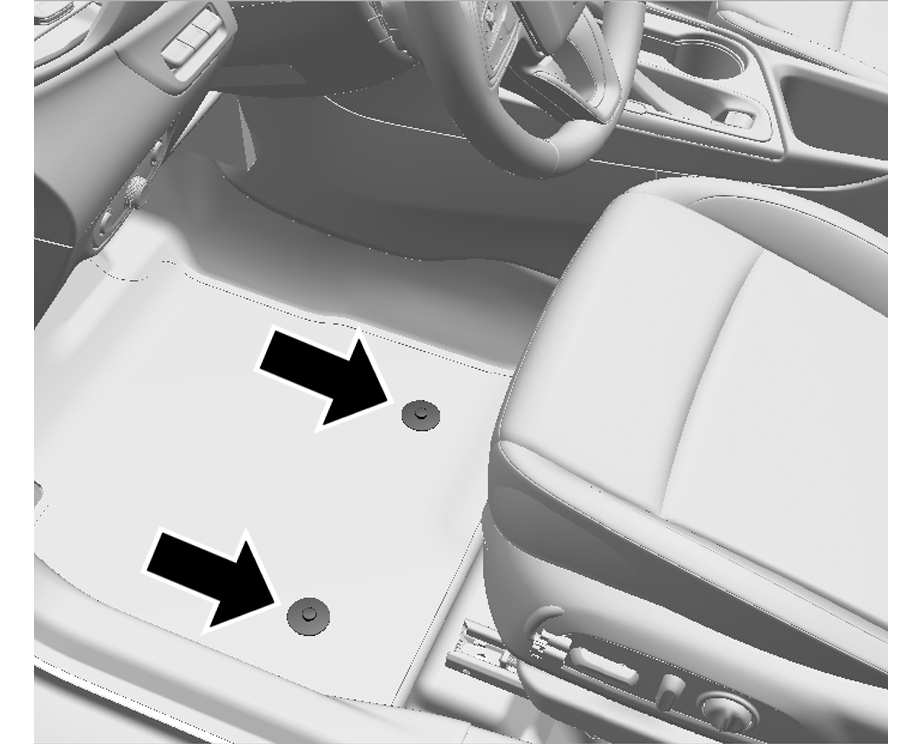
Removing and Replacing the Floor Mat
- Pull up on the rear of the mat to unlock and remove.
- Reinstall the floor mat by lining up the floor mat opening over the carpet retainer and snapping into position.
- Make sure the floor mat is properly secured. Verify the floor mat does not interfere with the pedals.
Cleaning Rubber Floor Mats (All-Weather Mats and Floor Liners)
See “Vinyl/Rubber” under Interior Care page 319 for important cleaning information.
FAQs
- How often should I change the oil in my Buick Encore GX 2023?
Your Buick Encore GX 2023 should have its oil changed about every 7,500 to 10,000 miles, or as needed, according to the oil life monitoring system. The owner’s manual, however, is always the best source for the manufacturer’s precise instructions. - What type of oil should I use for my Encore GX?
Depending on the engine, a different oil type may be suggested for the Encore GX. It is typically advised to use premium, dexos-certified oil that complies with the owner’s manual’s specification requirements. - How often should I rotate the tires on my Encore GX?
The tires on your Encore GX should generally be rotated every 6,000 to 8,000 miles or as directed by the tire manufacturer. Tire rotation on a regular basis helps to ensure even tire wear and extend the life of the tires. - Can I wash my Encore GX at an automatic car wash?
Yes, you can use an automatic car wash to clean your Encore GX. To prevent any potential harm to the vehicle’s exterior finish, it is advised to use touchless or soft cloth car washes. - How often should I replace the engine air filter in my Encore GX?
It is recommended to regularly check and, if necessary, replace the engine air filter. The engine air filter should typically be changed every 30,000 to 45,000 miles, or as specified by the vehicle’s maintenance schedule, depending on driving conditions. - Do I need to use a specific type of windshield washer fluid in my Encore GX?
Use of windshield washer fluid made specifically for use in automotive systems is advised. These fluids effectively assist in cleaning the windshield of dirt, debris, and grime from the road. - How often should I check the tire pressure in my Encore GX?
Checking the tire pressure in your Encore GX at least once a month is a good idea. The handling, fuel economy, and tire wear of the vehicle can all be impacted by incorrect tire pressure. - Can I use aftermarket accessories on my Encore GX?
On your Encore GX, it is possible to use aftermarket accessories, but it’s crucial to make sure they are compatible and installed properly. For advice, it is suggested that you speak with a reputable Buick dealership or automotive expert. - How often should I replace the cabin air filter in my Encore GX?
Every so often, the cabin air filter should be checked and, if necessary, replaced. The cabin air filter should typically be changed every 12,000 to 15,000 miles or as directed by the vehicle’s maintenance schedule. - Should I use fuel additives in my Encore GX?
The regular use of fuel additives in Buick vehicles is typically not advised. To ensure proper engine performance, it is best to use premium gas from reliable gas stations. - How often should I check the fluid levels in my Encore GX?
Regularly checking the fluid levels in your Encore GX, including the engine oil, coolant, brake fluid, and transmission fluid, is a good idea. For detailed directions and suggested timing, consult the owner’s manual. - Can I use wax or polish on the exterior of my Encore GX?
Yes, you can use wax or polish to protect and improve the paint finish on the exterior of your Encore GX. For best results, adhere to the directions given by the wax or polish manufacturer. - How often should I replace the wiper blades on my Encore GX?
When wiper blades begin to deteriorate or stop clearing the windshield as effectively as they once did, they should be replaced. Wiper blades should typically be changed every 6 to 12 months or as needed.
2023 Buick Encore Gx Specs, Price, Features, Mileage (Brochure)
Useful Links
View Full Manual: Buick Encore GX 2023 User Manual | Auto User Guide
Download Manual: Manuals and Guides | Vehicle Support | Buick
Related Article
2024 Buick Envista Specs, Price, Features, Mileage and Review
2023 Buick Enclave Specs, Price, Features, Mileage (Brochure)
2023 Buick Envision Specs, Price, Features, Mileage (Brochure)
2024 Buick Encore GX Specs, Price, Features, Mileage and Review

